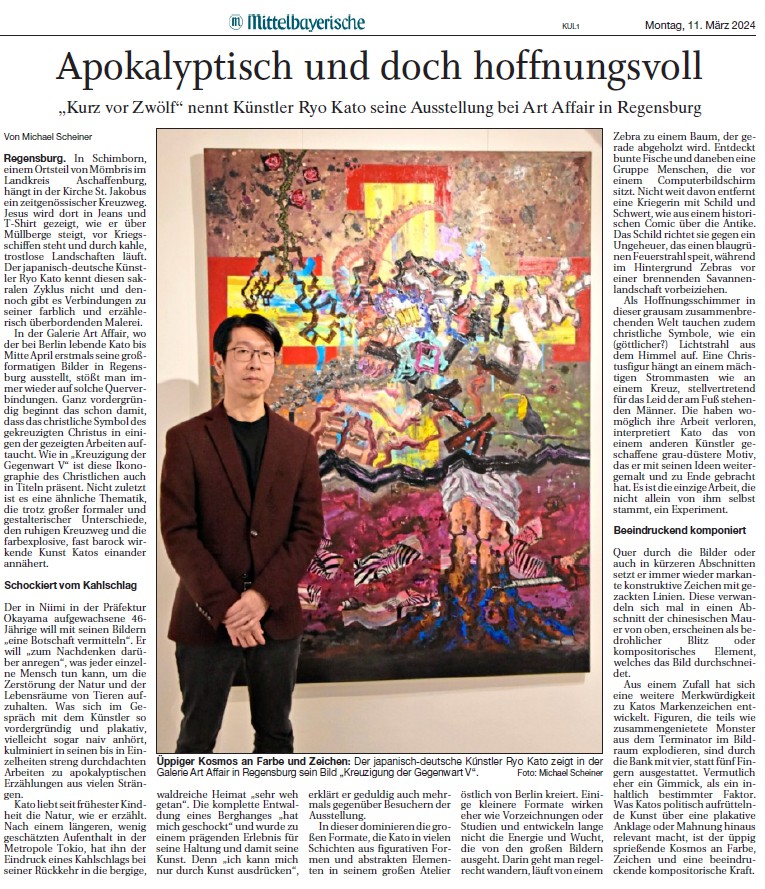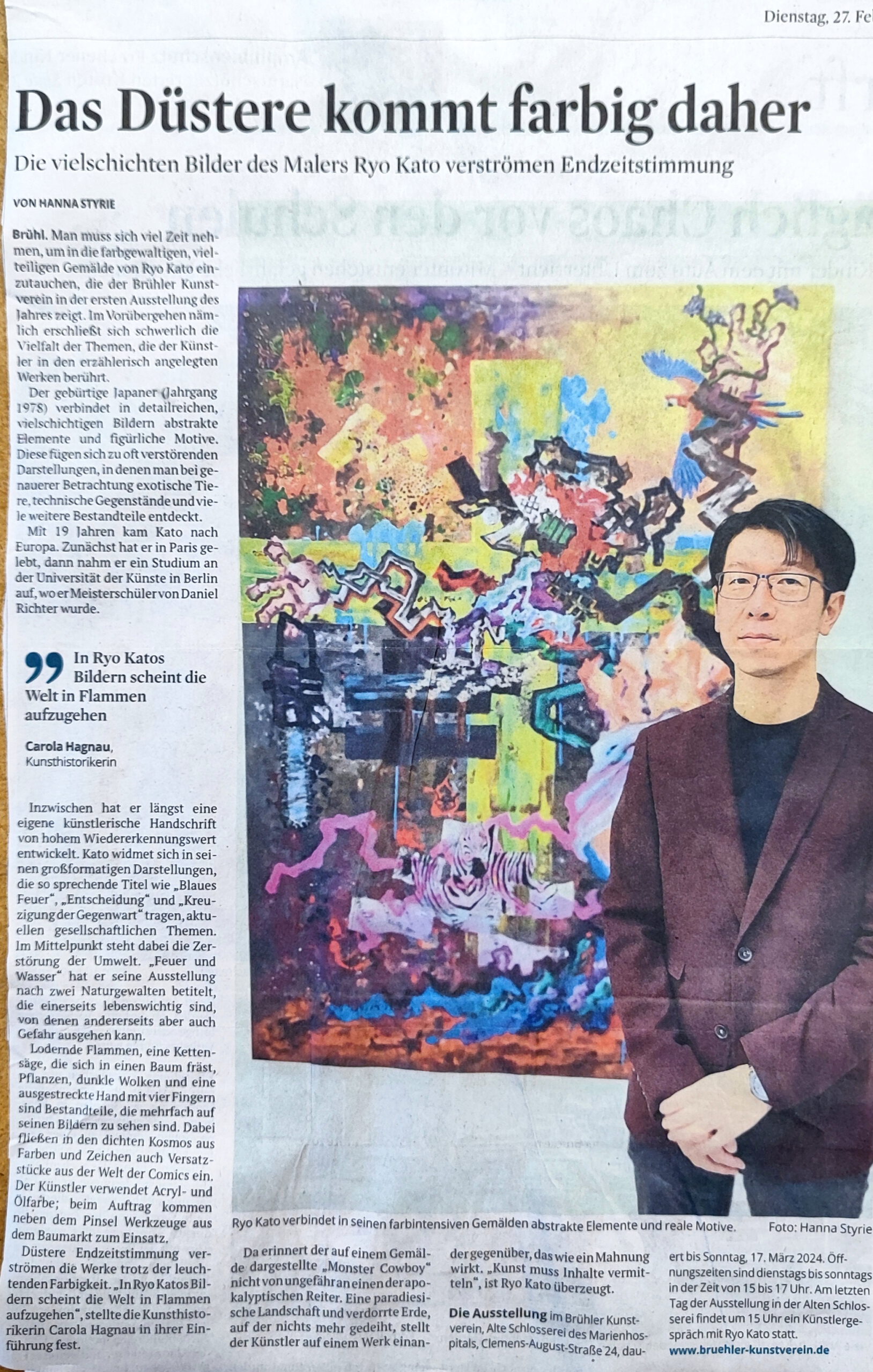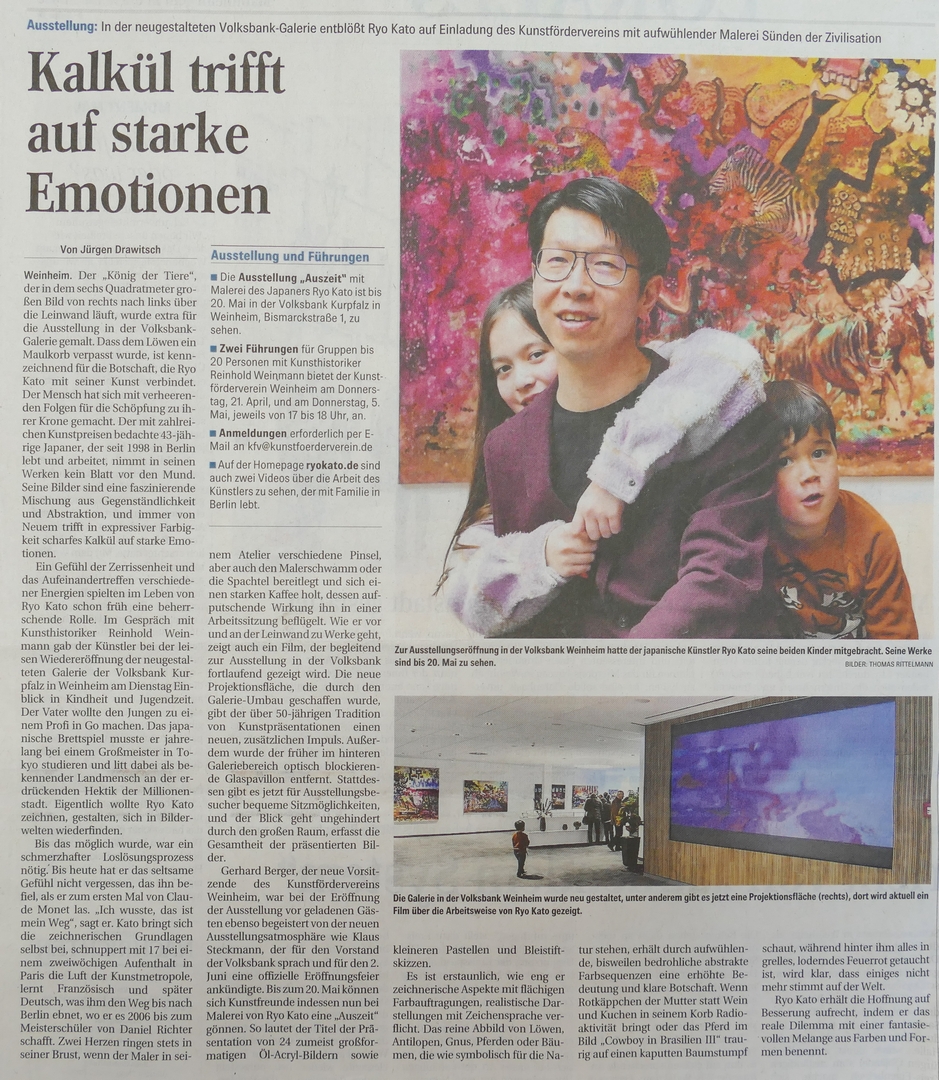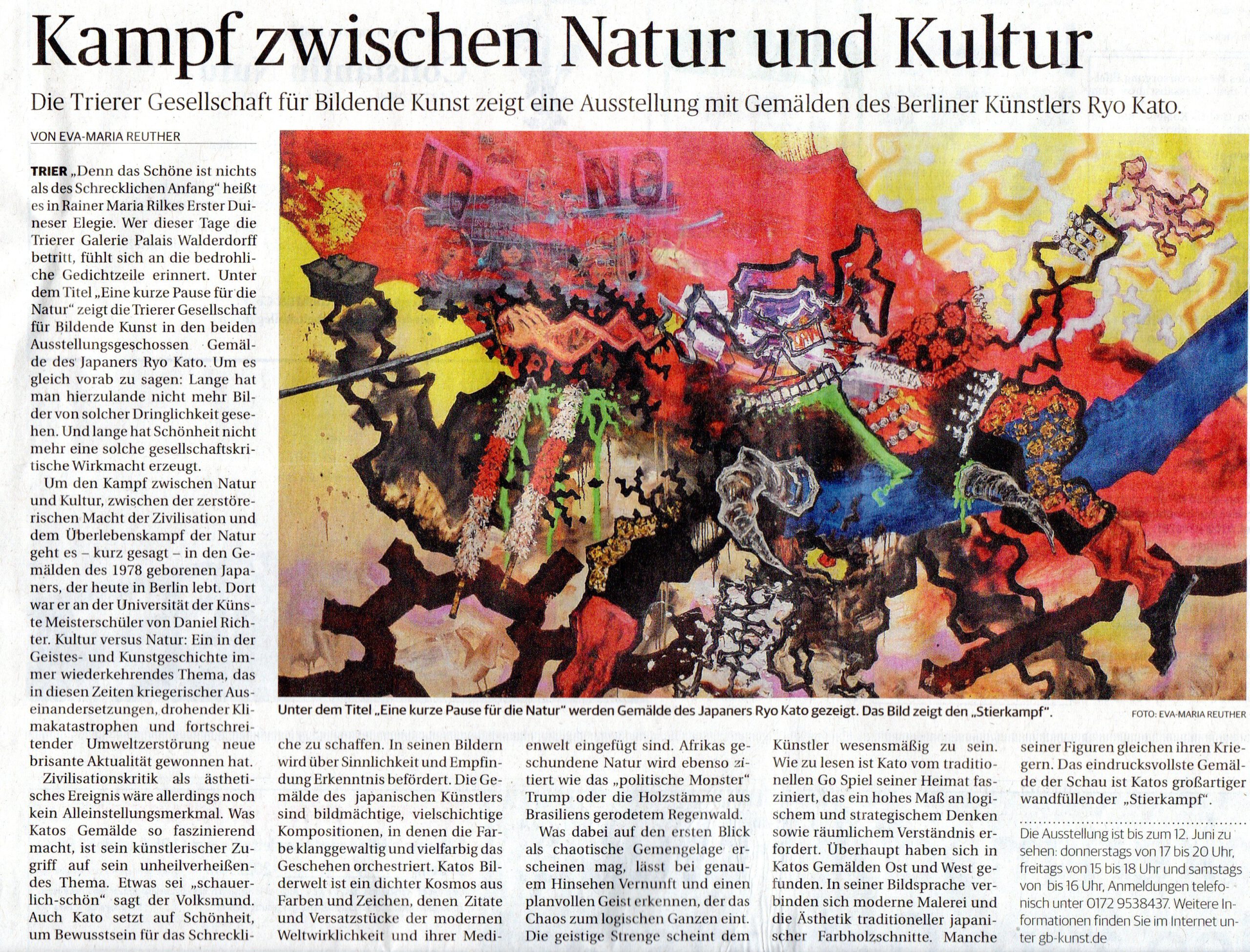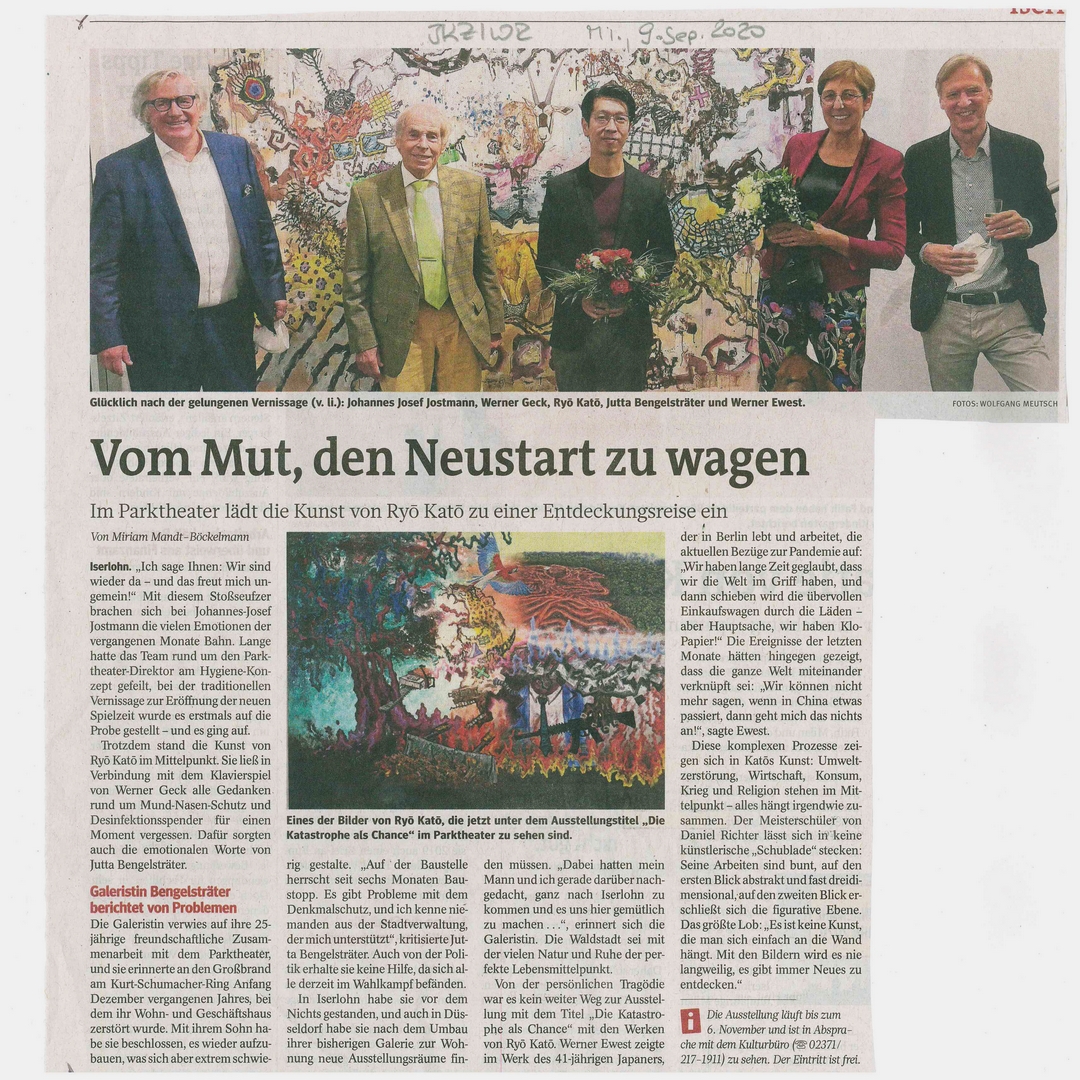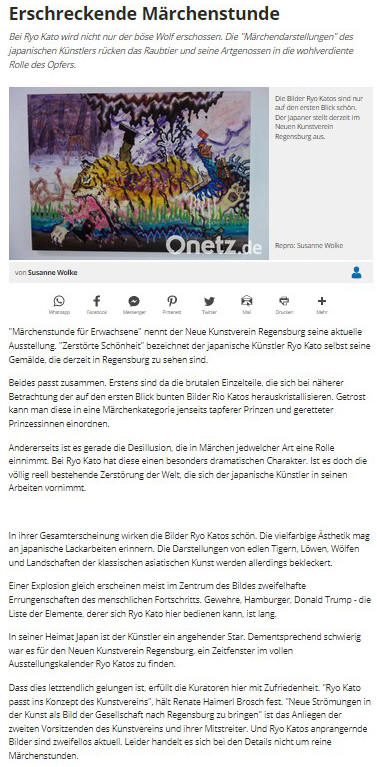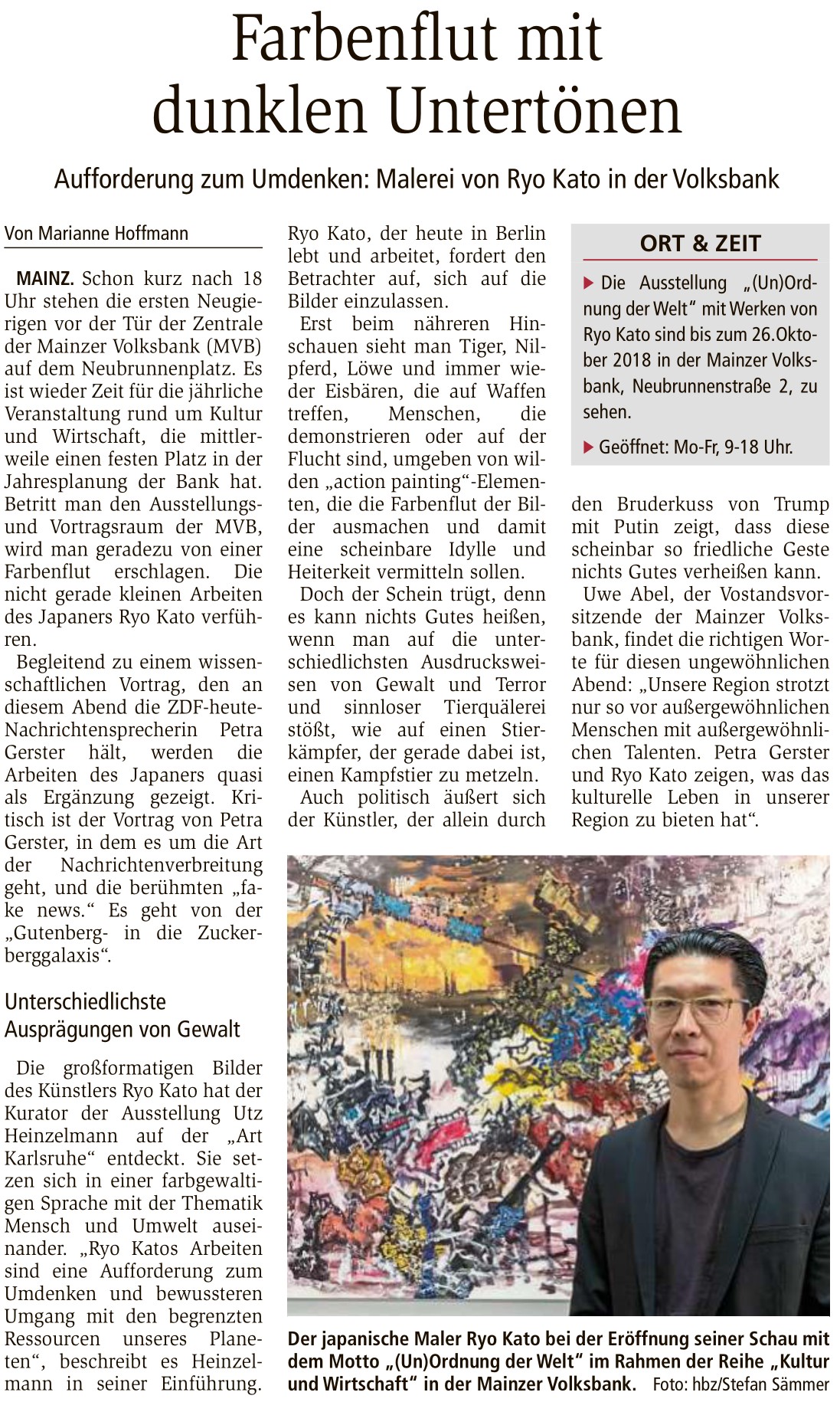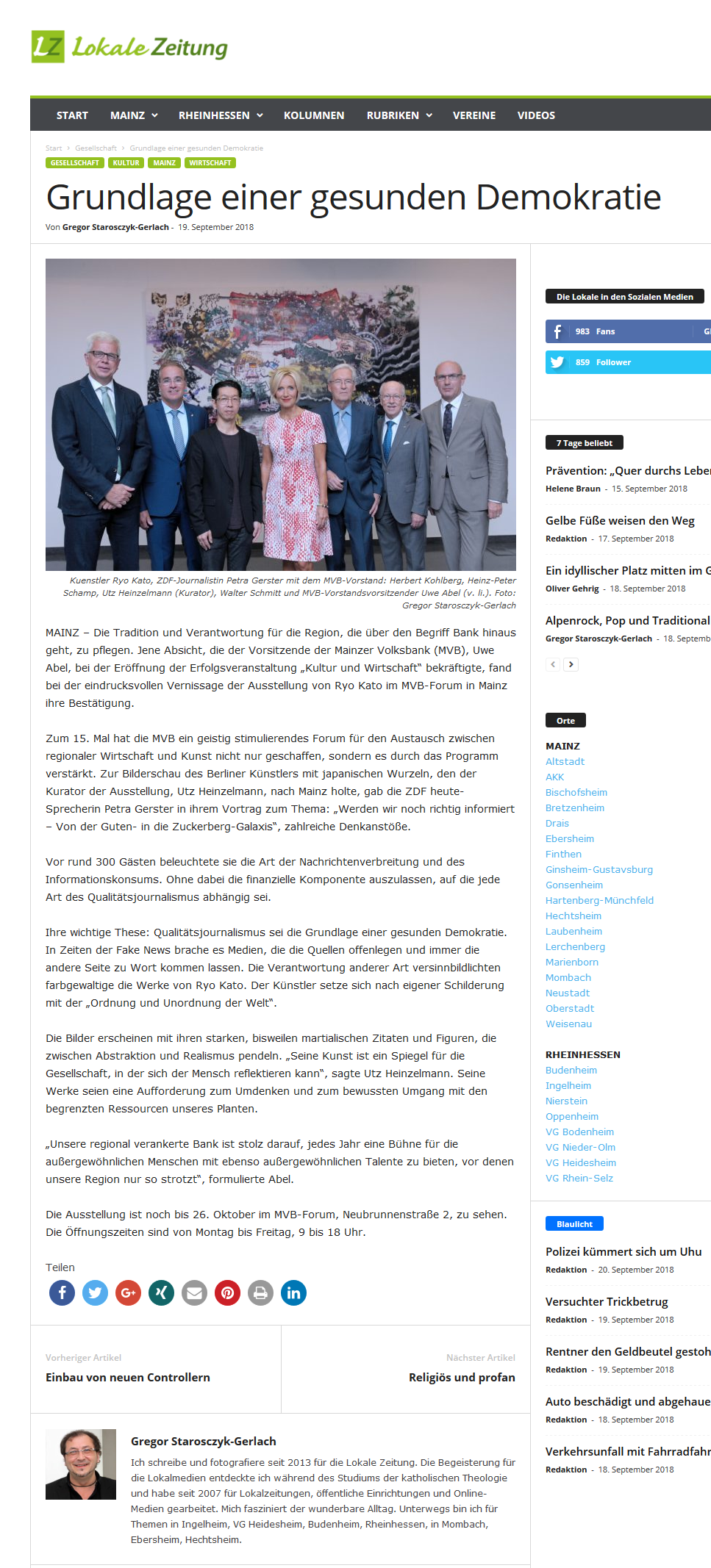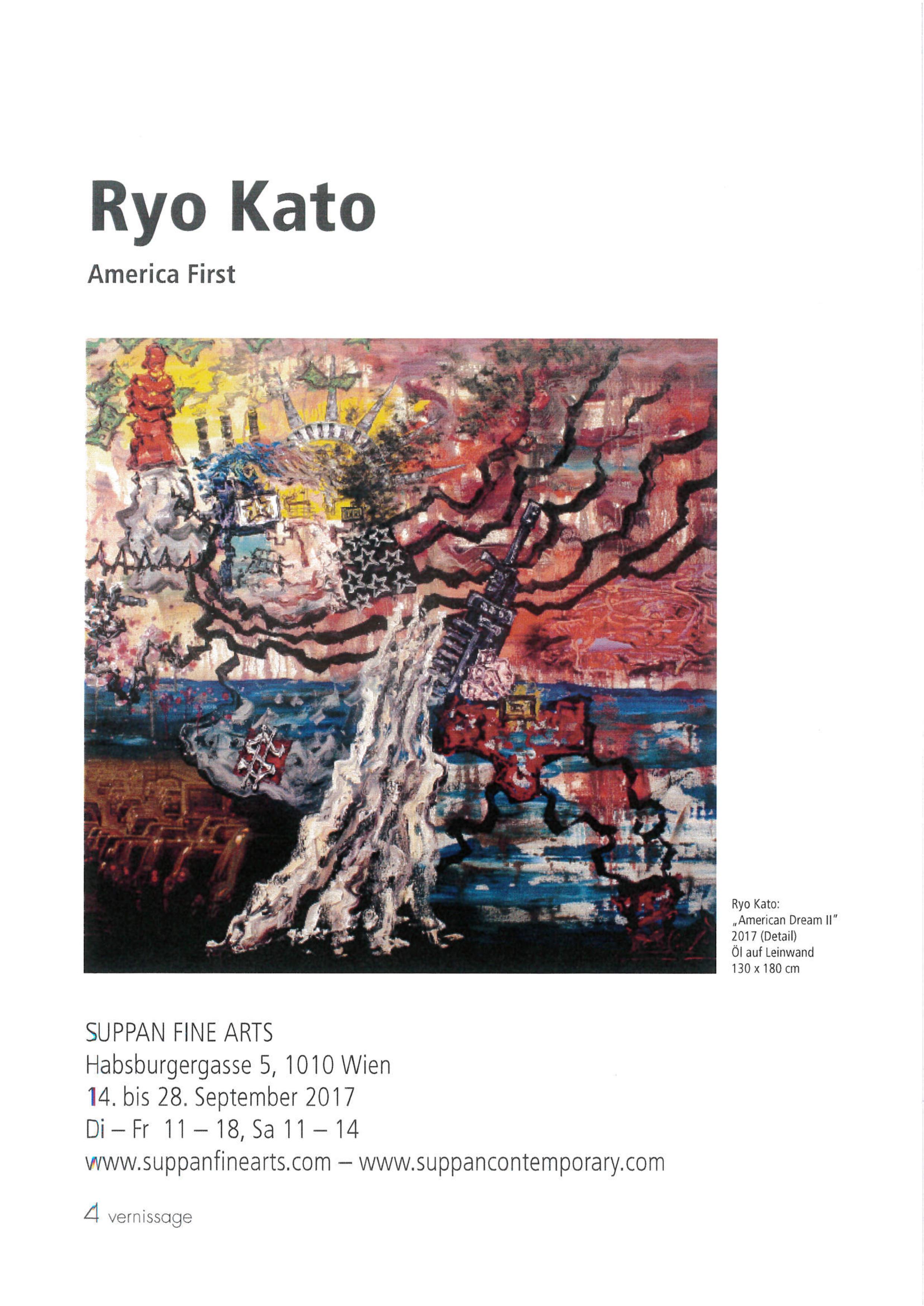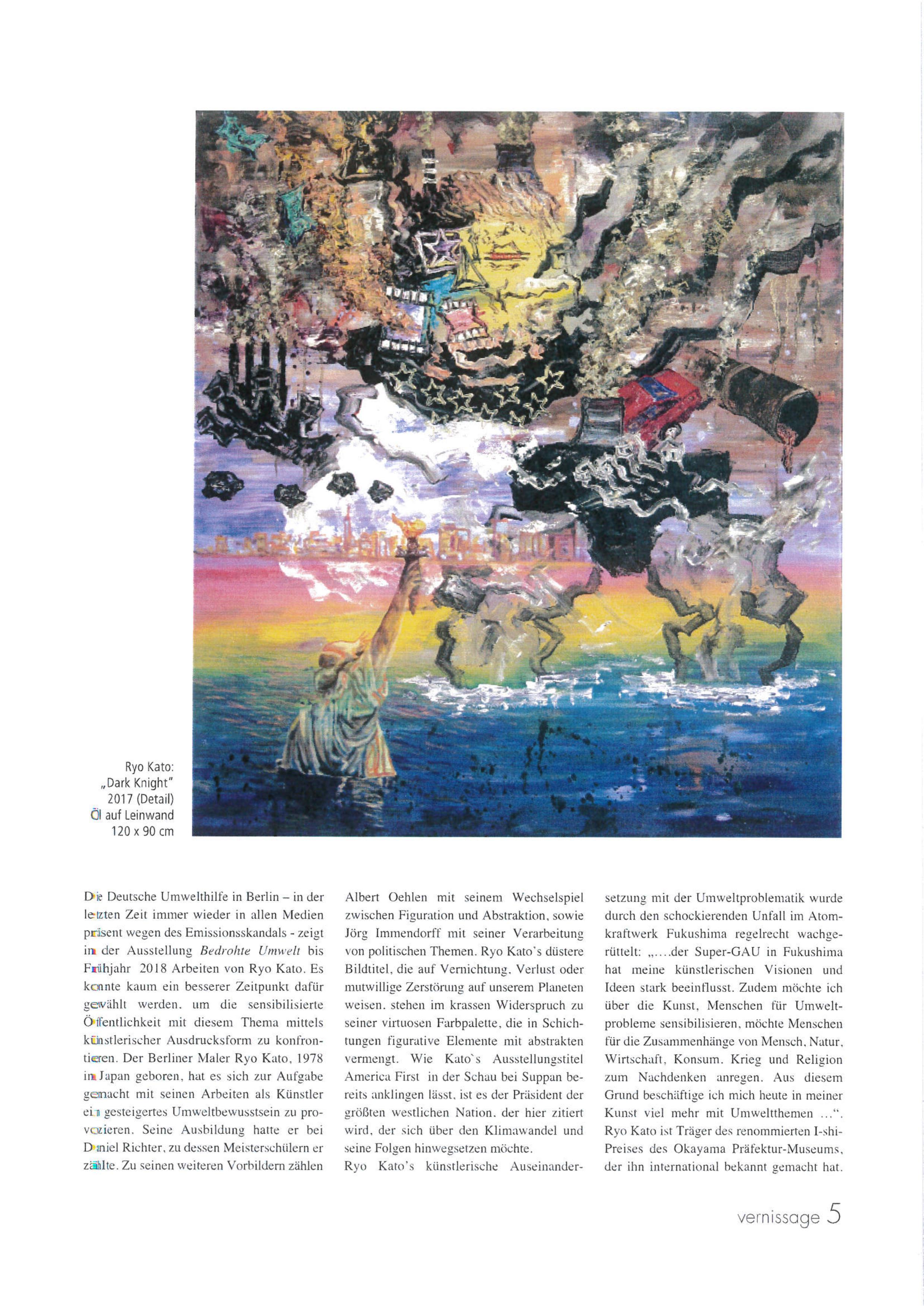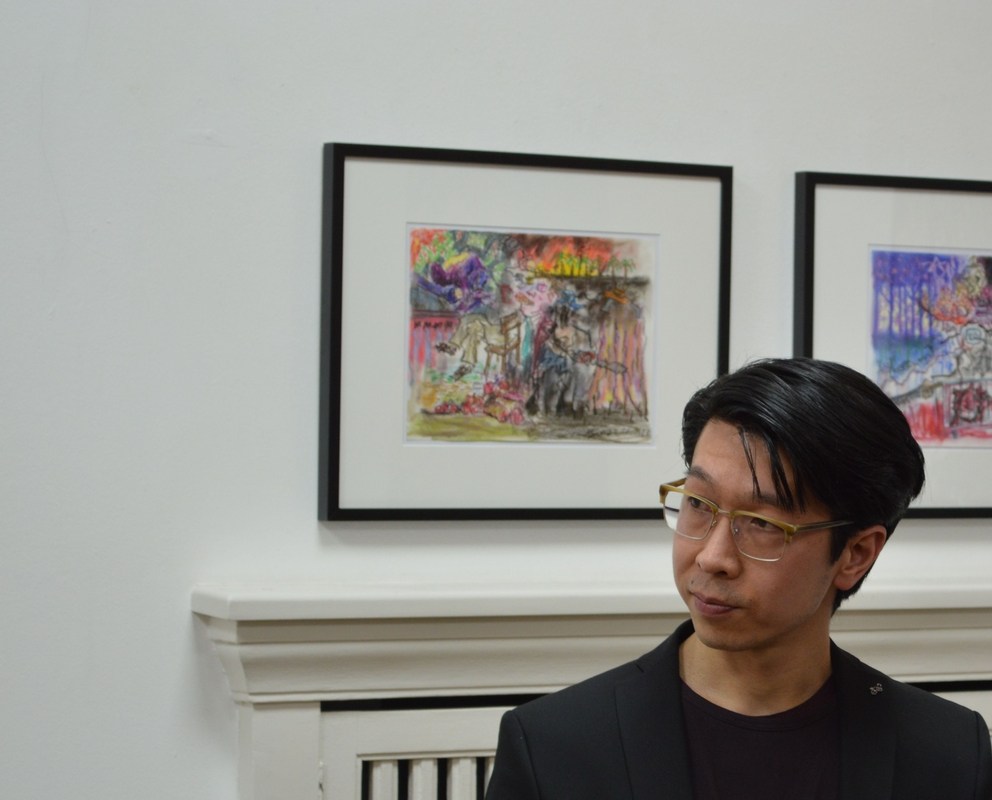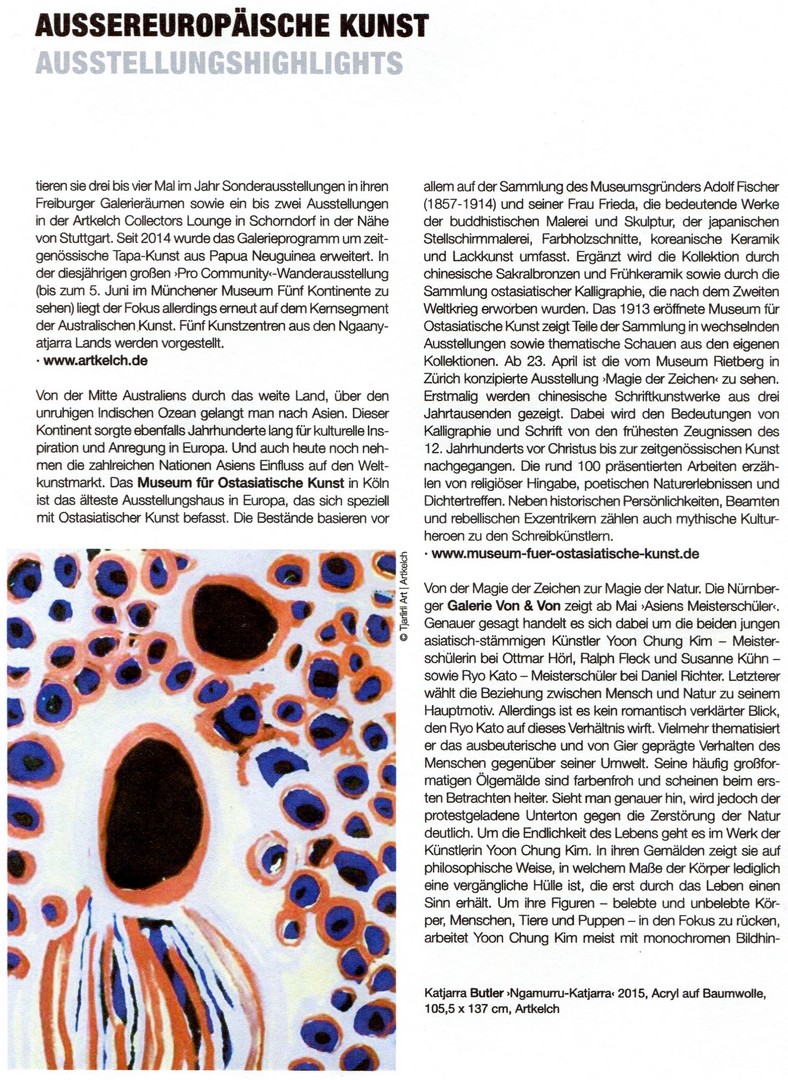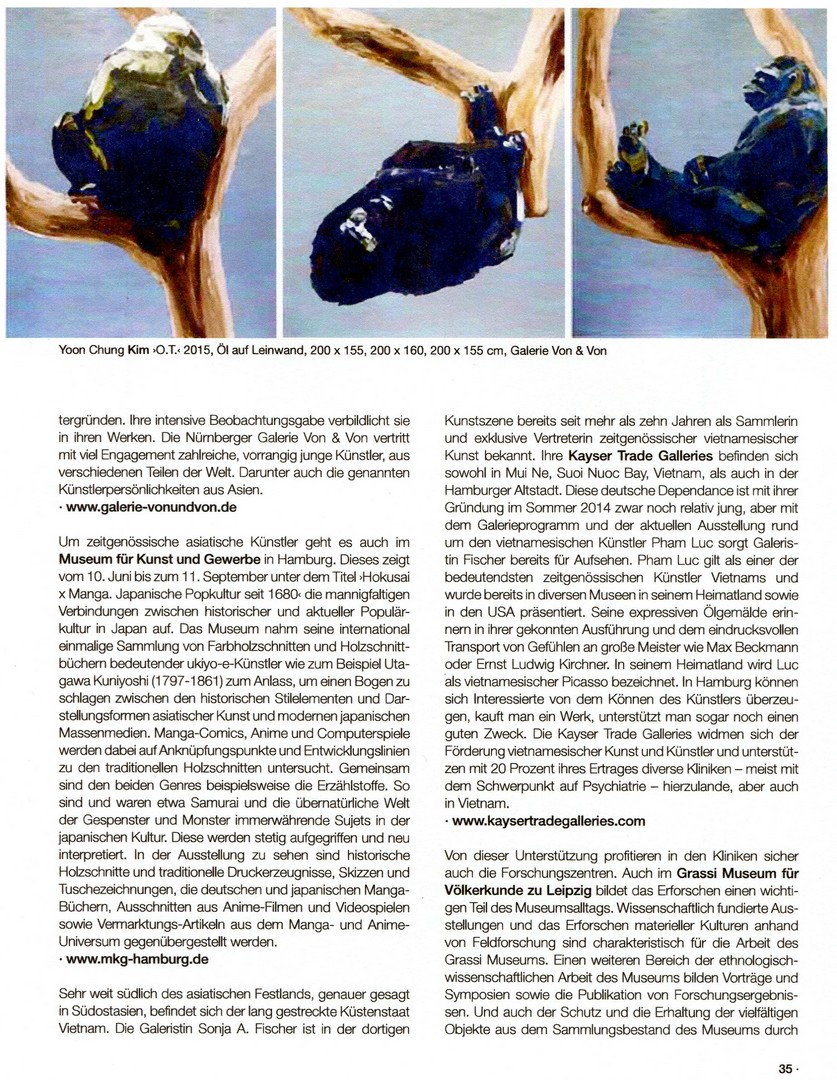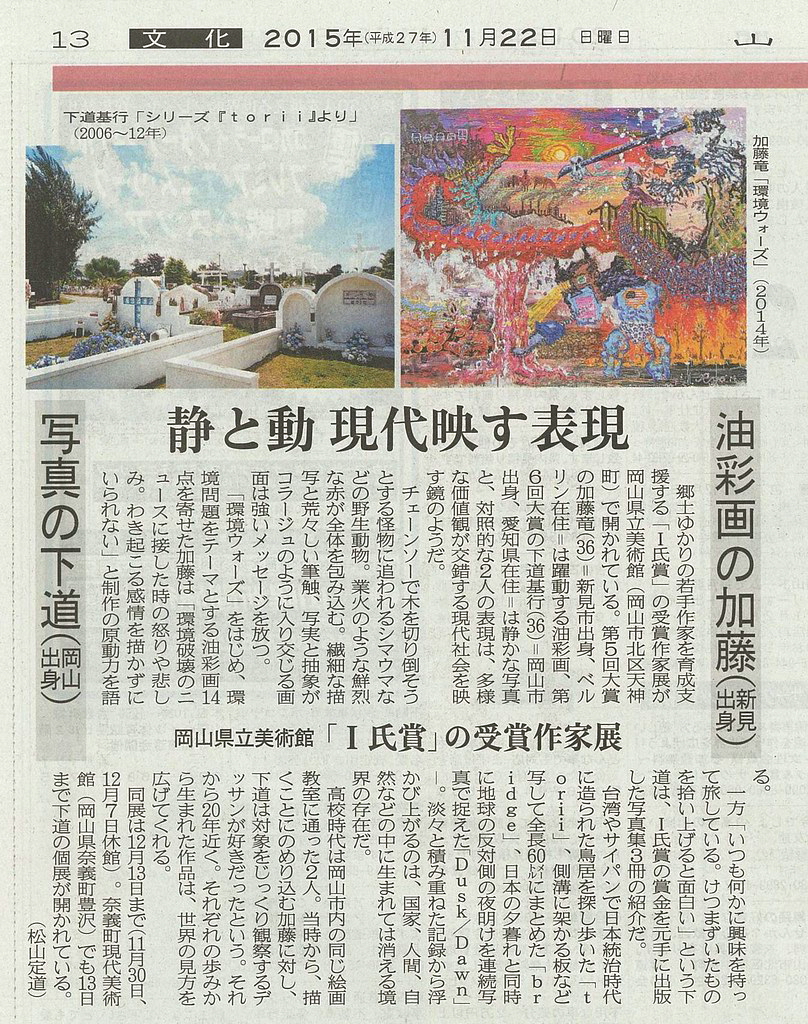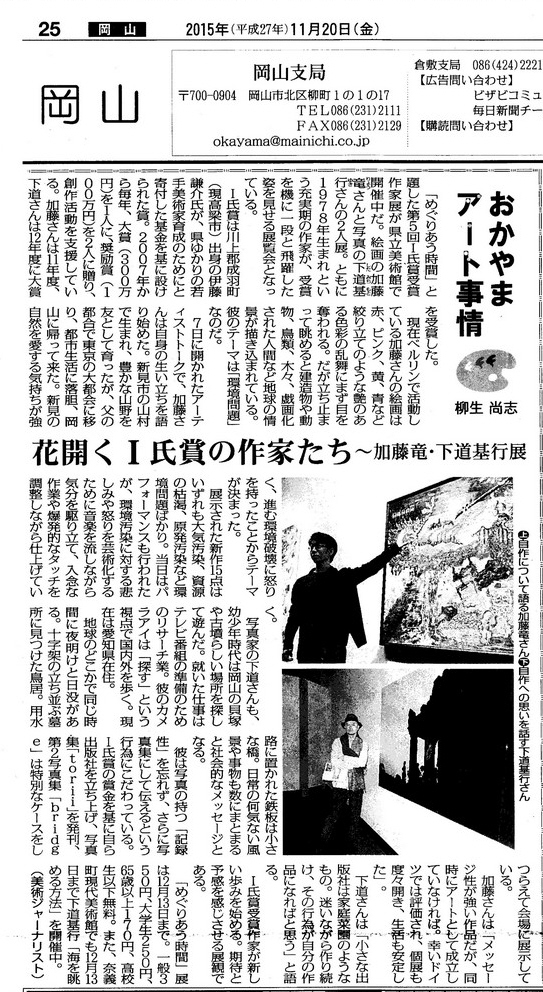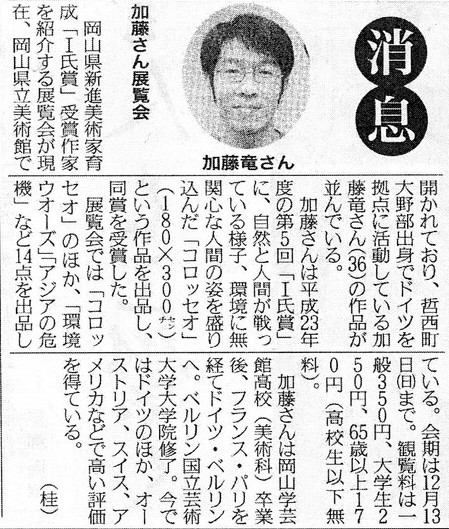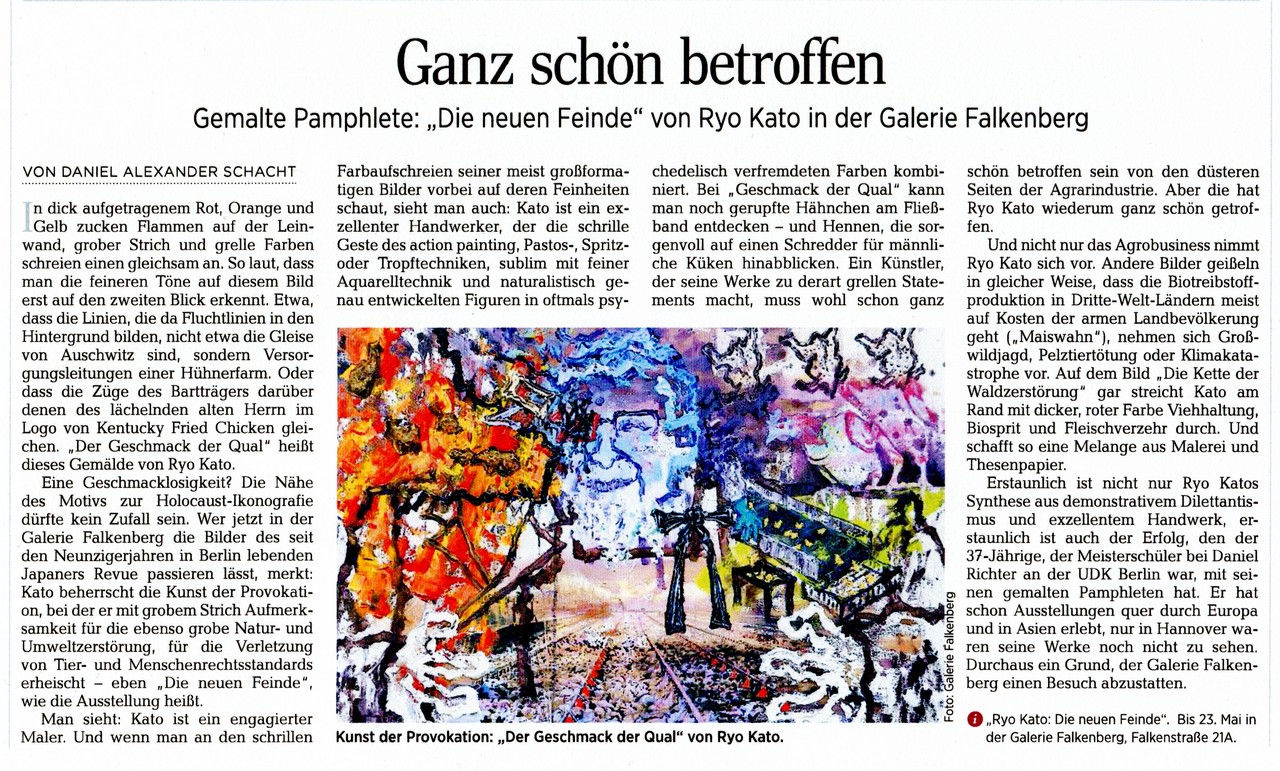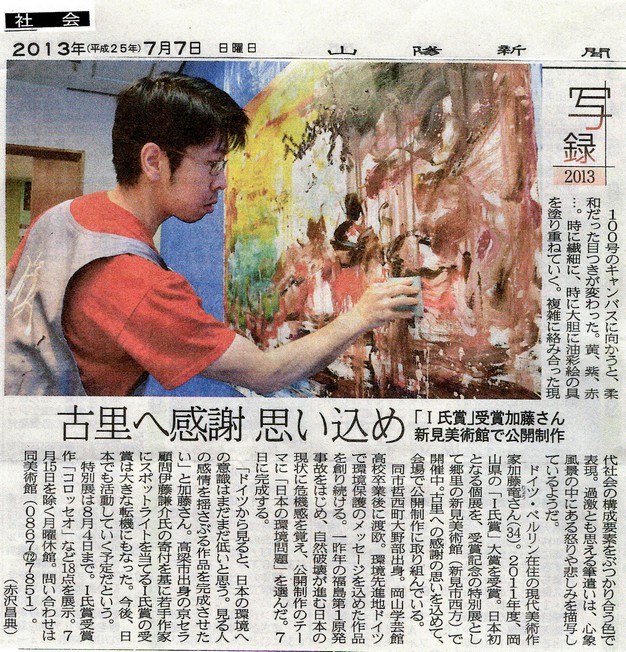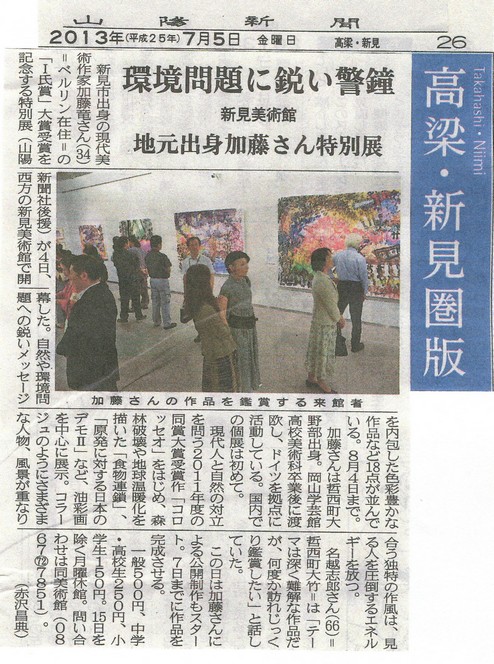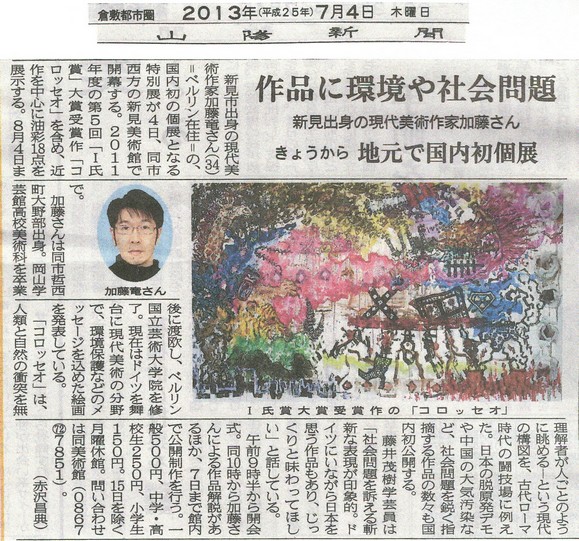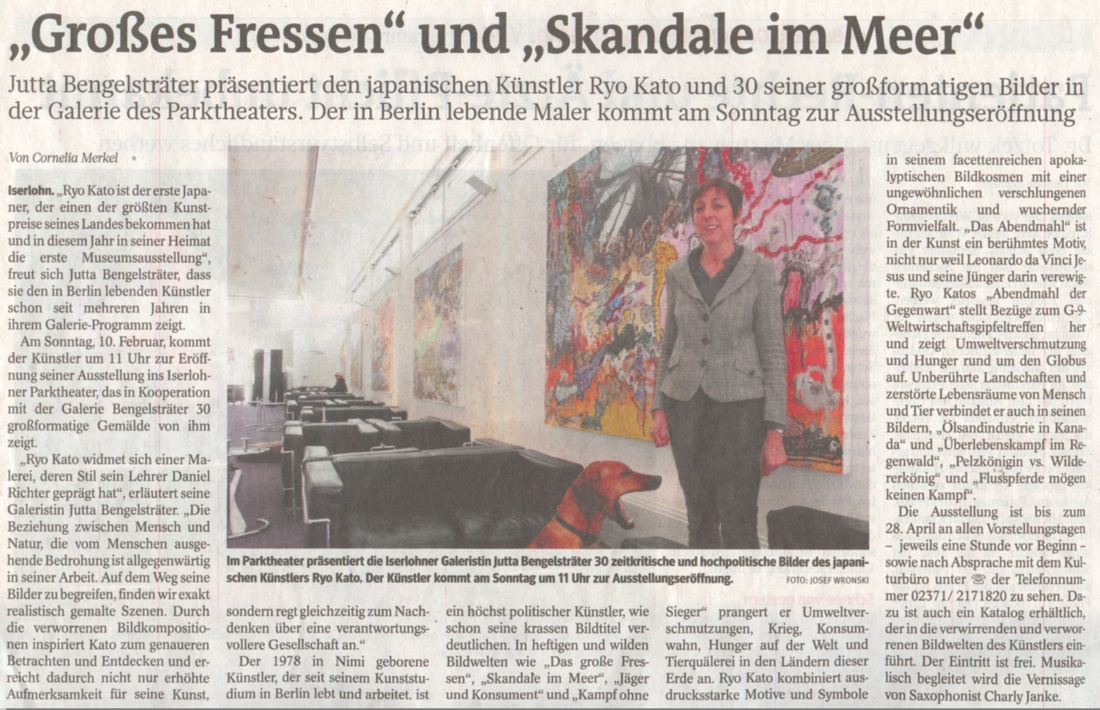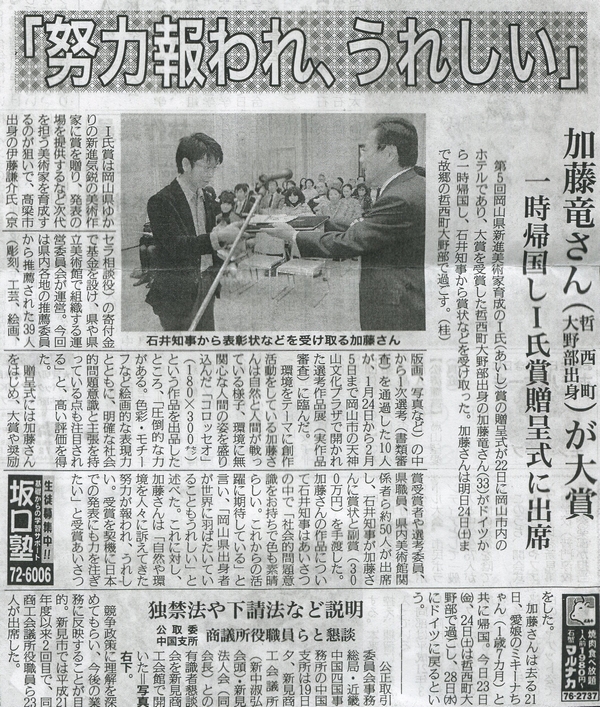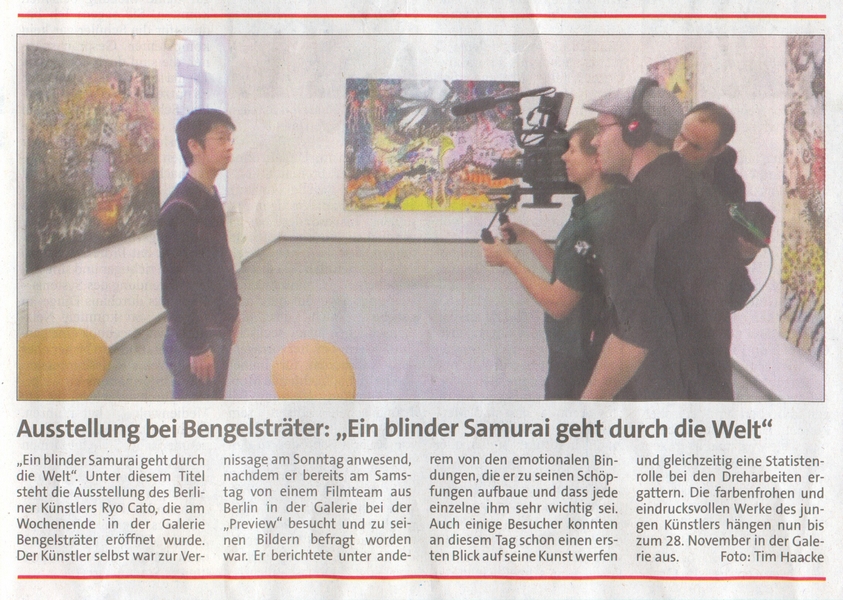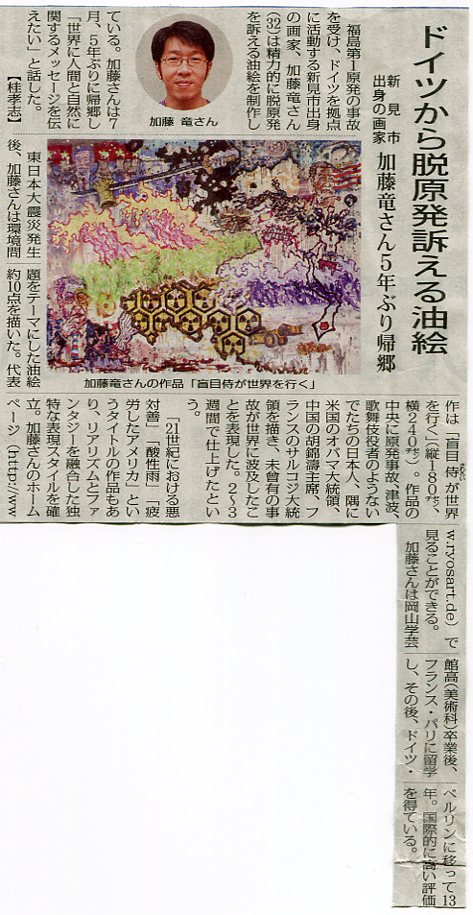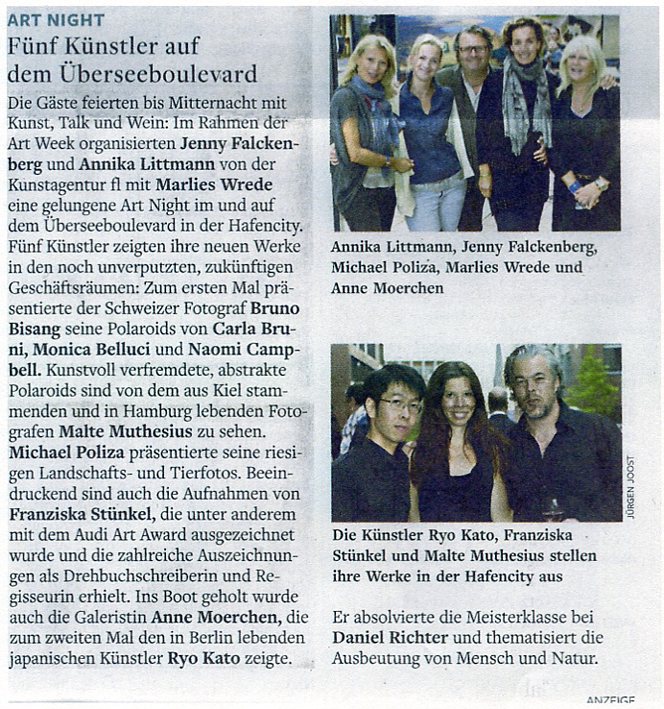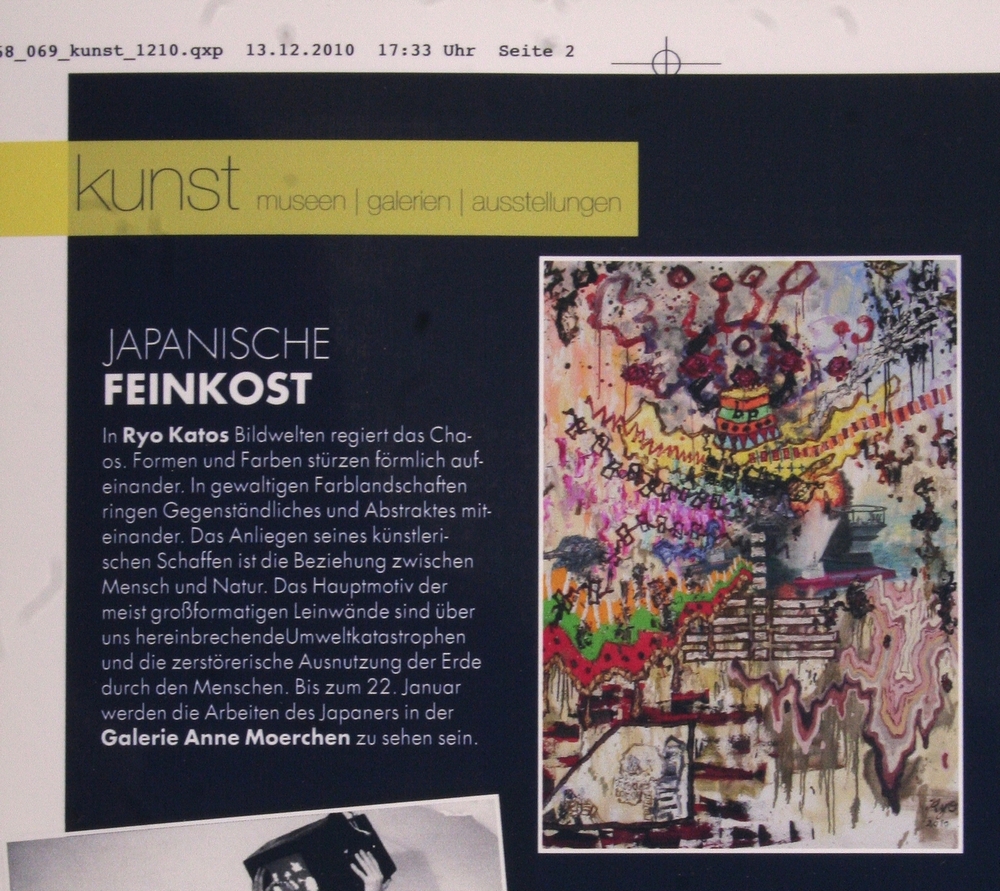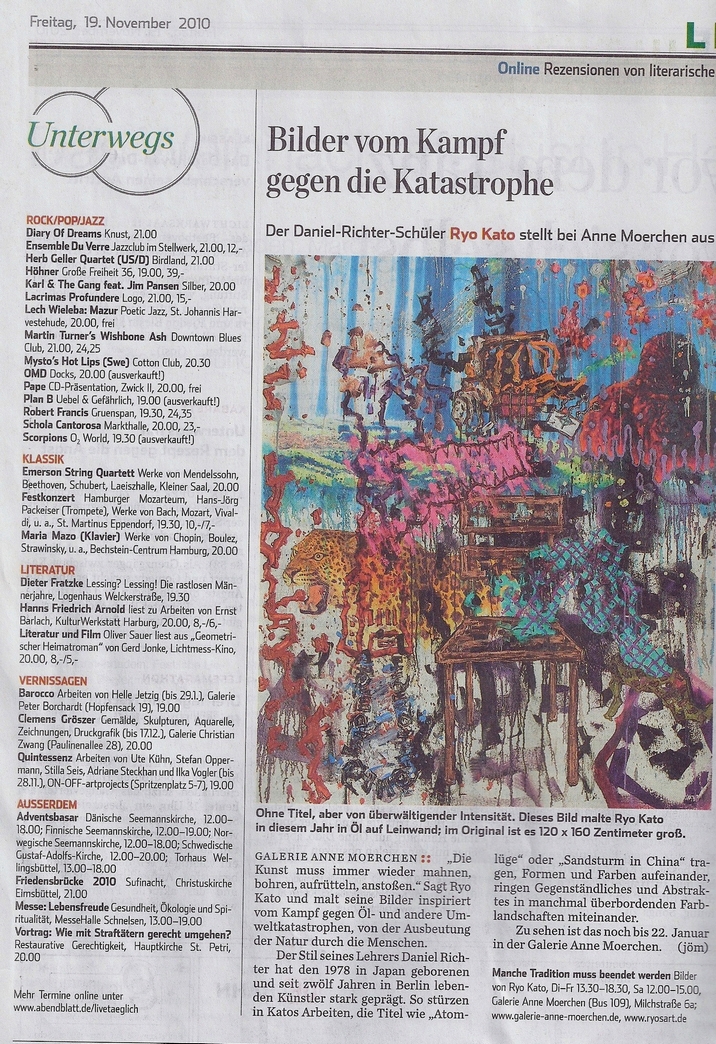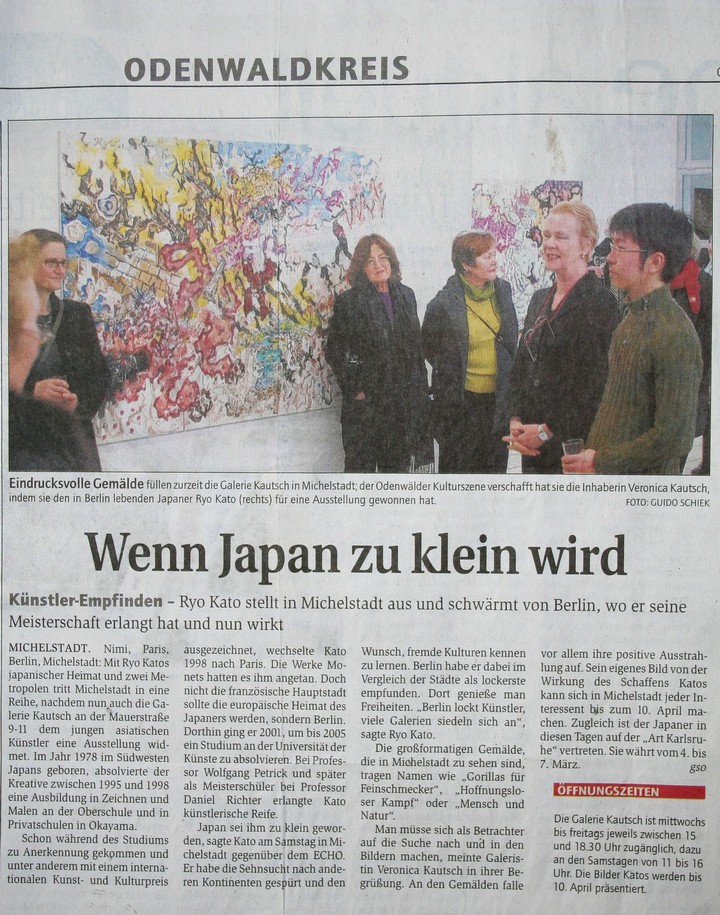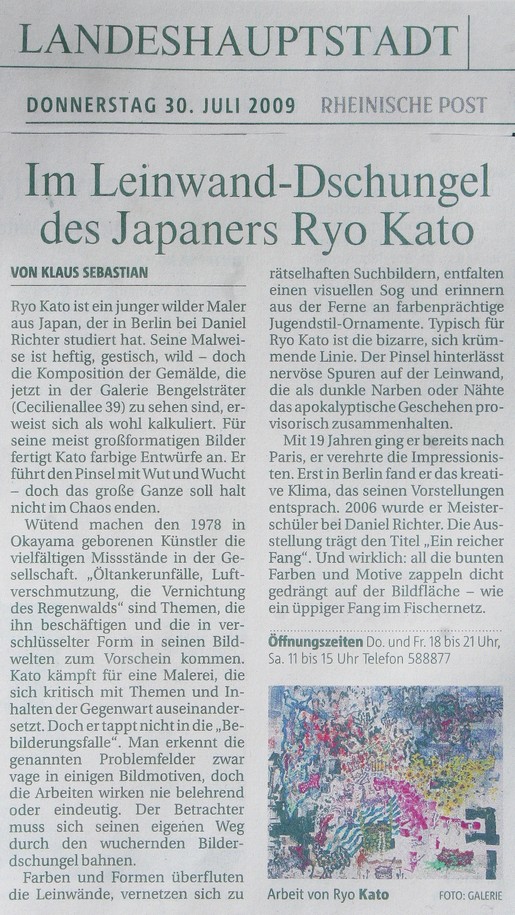11.03.2024
Newspaper article in the "Mittelbayerische" (Germany)
Apocalyptic and yet hopeful
Artist Ryo Kato calls his exhibition at Art Affair in Regensburg "Shortly before twelve"
By Michael Scheiner
Regensburg.
In Schimborn, a district of Mömbris in the county of Aschaffenburg, a contemporary Way of the Cross hangs in the church of St. James. Jesus is shown there in jeans and a T-shirt, climbing over mountains of garbage, standing in front of warships and walking through bleak, desolate landscapes. The Japanese-German artist Ryo Kato is not familiar with this sacred cycle and there are still connections to his colorful and narratively exuberant paintings.
At the Art Affair gallery, where Kato, who lives near Berlin, is exhibiting his large-format paintings in Regensburg for the first time until mid-April, one repeatedly encounters such cross-references. This begins with the fact that the Christian symbol of the crucified Christ appears in some of the works on display. As in "Crucifixion of the Present V", this iconography of Christianity is also present in the titles. Last but not least, it is a similar theme that brings the calm Stations of the Cross and Kato's color-explosive, almost baroque art closer together, despite major formal and design differences.
Shocked by the clear-cutting
The 46-year-old, who grew up in Niimi in Okayama Prefecture, wants to "convey a message" with his pictures. He wants to "make people think" about what each individual can do to stop the destruction of nature and animal habitats. What sounds so superficial and striking, perhaps even naive, in conversation with the artist, culminates in his works, which are rigorously thought through down to the last detail, into apocalyptic narratives made up of many strands.
Kato has loved nature since he was a child, as he explains. After a long, unappreciated stay in the metropolis of Tokyo, the impression of a clear-cutting on his return to his mountainous, "Shortly before twelve" is what artist Ryo Kato calls his exhibition at Art Affair in Regensburg "very painful". The complete deforestation of a mountain slope "shocked me" and became a formative experience for his attitude and thus his art. Because "I can only express myself through art", he patiently explains several times to visitors to the exhibition.
This is dominated by the large formats that Kato creates in many layers of figurative forms and abstract elements in his large studio east of Berlin. Some of the smaller formats look more like preliminary sketches or studies and do not develop the energy and force that emanates from the large paintings. You can wander through them regularly, walking from one zebra to a tree that is about to be cut down. You discover colorful fish and next to them a group of people sitting in front of a computer screen. Not far away is a female warrior with a shield and sword, like something out of a historical comic about antiquity. She is pointing the shield at a monster that is spitting a blue-green stream of fire, while zebras pass by in front of a burning savannah landscape in the background.
As a glimmer of hope in this cruelly collapsing world, Christian symbols also appear, like a (divine?) ray of light from heaven. A figure of Christ hangs from a mighty electricity pylon like a cross, representing the suffering of the men standing at the foot. They may have lost their jobs, Kato interprets the gloomy gray motif created by another artist, which he has continued to paint with his own ideas and brought to completion. It is the only work that is not entirely his own, an experiment.
Impressively composed
Across the pictures or in shorter sections, he repeatedly places striking constructive signs with jagged lines. These sometimes turn into a section of the Chinese wall from above, appear as a threatening flash or compositional element that cuts through the picture.
By chance, another peculiarity has become Kato's trademark. Figures, some of which explode in the frame like riveted-together monsters from the Terminator, are equipped with four instead of five fins across the board. Presumably more of a gimmick than an actual factor. What makes Kato's politically stirring art relevant beyond a striking accusation or warning is the lushly sprouting cosmos of color, signs and an impressive compositional power.
27.02.2024
Newspaper article in the "Kölner Stadt Anzeiger" (Germany)
The gloom comes in color
The multi-layered paintings by painter Ryo Kato exude an apocalyptic mood
By Hanna Styrie
Brühl. You have to take a lot of time to immerse yourself in the colorful, four-part paintings by Ryo Kato, which the Brühl Kunstverein is showing in its first exhibition of the year. The variety of themes that the artist touches on in his narrative works certainly shoots through in passing.
Born in Japan in 1978, he combines abstract elements and figurative motifs in detailed, multi-layered paintings. These combine to create often disturbing depictions that reveal themselves on closer inspection.
Kato came to Europe at the age of 19, initially living in Paris, before going on to study at the Berlin University of the Arts, where he became a master student of Daniel Richter.
In Ryo Kato's pictures, the world seems to go up in flames
Carola Hagnau
Art historian
He has long since developed his own highly recognizable artistic signature. In his large-format paintings, which bear such evocative titles as "Blue Fire", "Decision" and "Crucifixion of the Present", Kato focuses on current social issues. The focus is on the destruction of the environment. He has titled his exhibition "Fire and Water" after two forces of nature that are vital on the one hand, but can also pose a danger on the other.
Blazing flames, a chainsaw cutting into a tree, plants, dark clouds and an outstretched hand with four fingers are elements that can be seen several times in his pictures. Set pieces from the world of comics also flow into the dense cosmos of colors and symbols. The artist uses acrylic and oil paint; tools from the DIY store are used in addition to brushes.
Despite the bright colors, the works exude a gloomy apocalyptic mood. "In Ryo Kato's paintings, the world seems to go up in flames," said art historian Carola Hagnau in her introduction.
It is no coincidence that the "Monster Cowboy" depicted in one painting is reminiscent of one of the Horsemen of the Apocalypse. The artist juxtaposes a paradisiacal landscape and withered earth on which nothing thrives in a work that acts as a warning. "Art must convey content," Ryo Kato u is convinced.
The exhibition at the Brühler Kunstverein, Alte Schlosserei of the Marienhospital, Clemens-August-Straße 24, runs until Sunday, March 17, 2024. Opening hours are Tuesdays to Sundays from 3 to 5 pm. On the last day of the exhibition in the Alte Schlosserei, there will be an artist talk with Ryo Kato at 3 pm.
Ryo Kato combines abstract elements and real motifs in his colorful paintings.
Photo: Hanna Styrie
20.09.2018
Newspaper article in the "Lokale Zeitung"
The bedrock of a healthy democracy
By Gregor Starosczyk-Gerlach – 19 September 2018
MAINZ – Fostering tradition and responsibility for the region beyond the limited conception of a bank. This intention, reinforced by the chairman of the Mainzer Volksbank (MVB), Uwe Abel, at the launch of the successful event „Kultur und Wirtschaft“ (culture and business), saw its confirmation in the impressive opening of the exhibition of Ryo Kato at the MVB-Forum in Mainz.
This marked the 15th time that the MVB used its program to not only create but also enhance the exchange between regional business and art. The program included the presentation of paintings by this Berlin artist with Japanese roots, whom the curator of the exhibition, Utz Heinzelmann, had brought to Mainz. For the occasion, ZDF heute presenter Petra Gerster gave a lot of food for thought in her talk on the topic „Are we still getting properly informed – from the Gutenberg to the Zuckerberg galaxy“.
In front of 300 guests she examined the ways in which news are distributed and information is consumed – not overlooking the financial element that every kind of quality journalism would depend on.
Her strongest argument: Quality journalism is the bedrock of a healthy democracy. In times of “fake news” there would be a need for a media that discloses its sources and always gives a voice to the other side. Responsibility of a different kind was symbolized by the colourful works of Ryo Kato. By his own account, the artist confronts the „order and disorder in the world“.
His pictures come forth with powerful, sometimes martial quotes and characters oscillating between abstraction and realism. „His art is a mirror for society, through which people can reflect upon themselves“
Utz Heinzelmann said. Kato’s works would call for a change in thinking and for a conscious handling of the limited resources of our planet.
„Our locally anchored bank is proud to provide a platform every year for the extraordinary people with equally extraordinary talents that our region is brimming over with“, as Abel put it.
The exhibition is on show until October 26 at the MVB-Forum, Neubrunnenstraße 2. The opening hours are from Monday to Friday, 9 a.m. to 6 p.m.
September 2017
Article in the magazine "Vernissage " issue 334
Ryo Kato America First
The German environmental aid (Deutsche Umwelthilfe) in Berlin, which has recently appeared in all the media due to the emissions scandal, will be showing works of Ryo Kato in the exhibition "Threatened Environment" until spring 2018. It was hardly possible to choose a better time for confronting the sensitized public with this theme through artistic expression. The Berlin painter Ryo Kato, born in Japan in 1978, has made it his mission to provoke an increased awareness of the environment with his work as an artist. He had his apprenticeship with Daniel Richter, to whose masterclasses he counted. Among his further examples are Albert Oehlen with his interplay between figuration and abstraction, as well as Jörg Immendorff with his processing of political themes. Ryo Kato's gloomy pictographs pointing to destruction, loss, or wanton destruction on our planet are in stark contrast to his virtuoso color palette, which blends figurative elements with abstractions in stratifications. Like Kato's exhibition title America First in the show at Suppan, it is the president of the largest Western nation, which is quoted here, who would like to be concerned about climate change and its consequences.
Ryo Kato's gloomy pictographs pointing to destruction, loss, or wanton destruction on our planet are in stark contrast to his virtuoso color palette, which blends figurative elements with abstractions in stratifications. Like Kato's exhibition title America First in the show at Suppan, it is the president of the largest Western nation, which is quoted here, who would like to be concerned about climate change and its consequences.
Ryo Kato's artistic exploration of the environmental problem was awakened by the shocking accident at the Fukushima nuclear power plant: "... the super-GAU in Fukushima has greatly influenced my artistic visions and ideas. In addition, I would like to raise awareness about the art of raising people's awareness of environmental problems, to encourage people to think about the connections between man, nature, economy, consumption, war and religion. For this reason, I am much more concerned with environmental issues today in my art ... ". Ryo Kato is the recipient of the prestigious I-shi Prize of the Okayama Prefecture Museum, which has made him internationally known.
28.03.2017
Article in the magazine "Art and Science"
Irene Daum: Ryo Kato - Wanderer between the worlds
human and environment
The Berlin painter Ryo Kato, who was born in Japan in 1978, deals with a wide range of topics in the field of tension between humans and the environment. He speaks stories, draws on gloomy end-time scenarios, and punishes grievances such as the destructive intercourse of man with nature. This concern is also evident in the choice of the titles of his paintings. Examples are evil in the depth of man, the fourth world war or fight against monsters.
Ryo Kato's work is an invitation to rethink and more consciously deal with the limited resources of our planet. His colourful paintings are characterized by expressive motifs, an abundant abundance of details and multiple references and stratifications. Figurative elements such as animals or objects of everyday life act as a sight, they are familiar and known, which mixes with the unknown, the abstract elements. So Ryo Kato pulls the viewer into his gloomy and mysterious world. His works show the influence of his teacher Daniel Richter, also his attitude that a painting must be "socialized", that an artist must see it through the eyes of the beholder. He follows his model, Albert Oehlen, in his exploration of nature and culture and the interplay of figuration and abstraction. The influence of Jörg Immendorff is shown in allusions to the political events of the day and their processing in the picture. To Ryo Kato's self-image is that an artist must take a position and has a social responsibility.
Ryo Kato's work has been and still is decisively shaped by his personal career. The main influencing factors are his Japanese origins and his artistic training in the multicultural metropolis of Berlin. His work reflects an impressive interplay of the effects of a traditional education at a young age and freedom in artistic expression as an adult. The painter feels a strong connection with nature, typical of Japan. The strong sensitization to the stress field of man and the environment is not least to be seen in the disasters that his home country of Japan has been making a particular source of since the middle of the last century - nuclear bombs, natural catastrophes and economic crises.
Ryo Kato is a wanderer between the worlds of strictly scientific thinking and free painting. Already as a child, he had a mathematical high-grade recognition and graduated from a Go-Meister with the goal of a professional career as a Go-player. The handling of numbers and abstract structures, whose characteristics and patterns had to be investigated with the help of logic, exerted a lasting fascination on him. He inspired not only the abstract numerical sense, but also the computational grasping and understanding of spatial relationships, the geometry of surfaces and spaces, and, not least, the severity of the methods. Also as a painter, Ryo Kato needs clear structures as the foundation of his work. He plays with numbers and their linking in arithmetic; he is interested in numbers as an expression of proportions. Transferred to his art, he sees an analogy to mathematics when the combination of individual elements produces a total impression that has the quality of something new.
The board game Go is considered one of the oldest strategic games in the world. It places exceptionally high demands on strategic-logical thinking and the visual-spatial imagination. In each case alternately, two opponents place black or white stones on a board with the aim of conquering as large subareas as possible by suitable spatial formations. Winner is the one who ultimately dominates a larger total area on the board. The player must always keep an eye on the overall picture as well as the status of all local areas in order to emerge victorious from the game. Like the Go game, Ryo Kato is the canvas for the artist and the go-player Ryo Kato, which has numerous, at first glance, independent elements and spatial partial formations that interact with each other and uniquely characterize the overall overall event.
The complexity of the Go game and its affinity to algorithms are extremely high. The number of playable variants exceeds that of the chess game by magnitudes. While computer programs have been superior to chess grandmasters for years, a software only succeeded in defeating a leading international Go player last year, a milestone in the development of self-learning machines.
With the painter Ryo Kato, the subject of man and the environment triggers strong emotions, which flow into the design of his paintings. In the implementation of his ideas, he takes - apart from intuition - scientific-oriented strategic thinking and planning, with extraordinary results. The increasing international attention given to his work is reflected not only in numerous exhibitions and trade art fairs, but also in the award of prestigious art awards, e.g. the Darmstadt Secession and the Okayama Prefecture Museum in Japan.
His exhibition Ryo Kato - an endless story at the Galerie Bengelsträter in Düsseldorf until 8 May 2017 is currently on display. The German Environmental Aid (Deutsche Umwelthilfe) in Berlin shows his work on the topic of the "Endangered Environment" from 29 March 2017 to 2 April 2018.
May 2017
Article in the magazine "Kunsttermine"
Page 1
NON-EUROPEAN ART
EXHIBITION HIGHLIGHTS
From the magic of symbols to the magic of nature. Beginning in May, Nuremberg’s Galerie Von & Von exhibits „Master Scholars from Asia“. More specifically, on display are two young artists originating from Asia: Yoon Chung Kim, master scholar with Ottmar Höri, Ralph Fleck, and Susanne Kühn; and Ryo Kato, master scholar with Daniel Richter. The latter has chosen the relationship between humans and nature as his central theme. It is, however, not a romantically transfigured look that Ryo Kato casts on this relation. Instead, his subject is the exploitative and greed-driven conduct of humans towards their environment. His often large-format oil paintings are colourful and seem joyful at first glance. Once you look closer, however, the protest-laden undercurrent against the destruction of nature becomes apparent.
… Galerie Von & Von in Nuremberg represents numerous, primarily young artists from various parts of the world, with a lot of commitment. Among them, the two artists mentioned above.
22.11.2015
Newspaper article in the Sanyoshinbun
Calm and Movement, Expression of the Present
Oil painting: Ryo Kato (Niimi)
Photography: Motoyuki Shitamichi (Okayama)
The "I-Shi Prize Winner" exhibition takes place in the Okayama prefecture museum.
(The I-Shi prize supports and promotes local artists.)
The 5th prize winner Ryo Kato (36) (from Niimi living in Berlin) shows lively oil paintings.
The 6th prize winner Motoyuki Shitamichi (36) (from Aichi) shows peaceful photos.
These two deeply contrasting works act like mirrors, showing the present society in which manifold values intersect.
Animals flee from monsters, which cut down trees with chainsaws.
The red of the flames envelops the whole.
The fine expression and violent brushwork form a painting in which realism and abstraction are presented as a collage, conveying this powerful message.
Altogether, Ryo Kato exhibits 14 paintings here. Included is his piece "Environmental Wars", about which he has made the statement: "I have to paint about my feelings as soon as I get news about environmental destruction.."
....
Both artists studied in the same painting academy during high school.
At that time, Kato was already fascinated with painting, whereas Shitamichi liked drawing, where you had to look closely at objects.
After 20 years, the works of both artists, though created by different techniques, together share their perspectives with the world.
Sadanobu Matsuyama
20.11.2015
Newspaper article in the "Mainichishinbun"
Okayama art situation
The I-Shi prizewinners won impetus
Ryo Kato und Motoyuki Shitamichi
At the moment, it takes place in the Okayama prefecture museum the 5th „I-Shi prize winner" exhibition, with Ryo Kato (artist) and Motoyuki Shitamichi (photographer).
Both are born in 1978 and live in their filled-out phase. In the exhibition one clearly recognises the big jump which both artists have reached by the price.
The I-Shi-prize was founded by a donation from Mr. Kensuke Ito from Kawakami-gun Nariwa-Cho (today Takashi), to support local linked artists and to promote. Since 2007, it gives each year to support an artist the first prize of 3000.000 Yen, and two artists, the support price of 1000.000 Yen.
Kato won 2011 the price and Shitamichi 2012.
In the works of Kato, who lives in Berlin, first a wild dance of brilliant colors attracts out. Red, pink, yellow, blue, as if they were freshly pressed from the tube. But when looking at the painting then more precisely, also building, animals, birds, trees, and caricature people attract out. His subject is the environmental problems.
At the artist talk at 07.December, he began to tell about his resume. He was born in a small village in Niimi and grew up in nature. Because of his father, he moved to the big city Tokyo. Disappointed by the big-city life he returned later to Okayama.
He fixed his theme by his feeling and love for nature that was so strong in Niimi, but was annoyed about the progressive environmental degradation.
The themes of this time, 15 exhibited new works that act exclusively on environmental problems such as. Air pollution, energy shortage and environmental pollution by nuclear power plants.
On the day of the artist-speech, he also organized a painting performance.
Thereby he let direct his feelings through music to express his rage against the pollution of the environment, with controlled, careful manner of painting and the detonating brush strokes to as art.
...
Kato said: "My works are meaningful, but at the same time they must pass also for contemporary art. Fortunately, my art is recognised in Germany. I often exhibit and earn with it enough for my living.
…
The I-Shi Prize winner to take new steps. It let feel the vision, the expectation and the presentiment.
Art journalist
22.11.2015
Newspaper article in the "Bihokuminpou"
Signs of life
Exhibition of Ryo Kato
In Okayama's Prefectural Museum an exhibition is currently taking place. Will be presented works of the winners of the Okayama aiming high artist education, "I-Shi-price". Among them also works of Ryo Kato (36) from Oonobe are to be seen, whose main activity is in Germany.
Kato applied for the 5th I-Shi-Prize (2012) with the painting "Colosseum" (180x300cm), which shows the struggle between man and nature, as well as the disinterest of the people for the environment. He won the prize. With it he won the prize.
Alltogether 14 works are exhibited, besides "Colosseum", there are still "The Environmental War" and "The Need of Asia" to see.The exhibition runs until December 13th.The admission cost for adults is 350 Yen, students 250 Yen, the persons over 65 years 170 Yen (until high school students free).Kato moved after the completion of the Gakugeikan high school, Kato moved to Paris, then to Berlin.He completed his art studies as a master class student at the University of the Arts in Berlin.Today he gets good reviews from Germany and other countries.
Katsura
20.04.2015
Newspaper article in the "Hannoverschen Allgemeinen Zeitung"
Pretty well concerned
Painted pamphlets: "The new enemies" by Ryo Kato at Galerie Falkenberg
BY DANIEL ALEXANDER BACH
Flames of red, orange, and yellow are thickly applied and seem to twitch on the canvas, as if the coarse lines and bright colors scream at the viewer. They are so loud that the subtle details in this painting can only be recognized upon a second glance. For example, the vanishing lines in the background are not the rails of Auschwitz, but rather the supply lines of a chicken farm.
Or that the bearded guy's features above resemble those of the smiling old man in the Kentucky Fried Chicken logo. "The Taste of Agony" is the title of this painting by Ryo Kato.
Distasteful? The proximity of the motif to Holocaust iconography is likely no coincidence.Anyone reflecting upon the paintings on display at Galerie Falkenberg by the Japanese artist, who has been living in Berlin since the 1990, realizes: Kato is a master of the art of provocation; he employs coarse lines to demand attention to the equally coarse natural and environmental destruction, to the violations of animal and human rights standards – "The New Enemies”. Hence the title of the exhibition.
As you can see from his mostly large format paintings: Kato is an engaged painter. And when you look at the subtleties, beyond the shrill colors shouting out from his paintings , you can also see: Kato is an excellent craftsman who combines the bold techniques of action painting, impasto, spraying or dripping techniques in sublime ways with fine watercolor techniques and figures in often psychedelically distorted colors.
In "Taste Of Agony," you can even discover plucked chicken on the assembly line - and hens anxiously looking down at a shredder for male chicks. An artist who turns his works into such piercing statements must be pretty well concerned by the dark sides of the agricultural industry. But Ryo Kato pretty well captured them too.
And it is not only the agrobusiness that Ryo Kato takes to task. Other paintings similarly castigate the production of biofuels in third world countries, which is mostly at the expense of the poor country’s population ("Corn Craze") and take on big-game hunting, the killing of fur animals, or the climate catastrophe. At the edge of the picture "The Chain of Forest Destruction," Kato even uses thick red paint to cross out cattle keeping, biofuels, and meat consumption. And thesis paper.
What is astonishing is not only Ryo Kato's synthesis of demonstrative dilettantism and excellent craftsmanship, but also the success that the 37-year-old artist has had with his painted pamphlets.
This master student of the class of Daniel Richter at UDK Berlin has already exhibited across Europe and Asia, but his works had not yet been shown in Hannover: definitely a good reason to visit Galerie Falkenberg.
Art of provocation: "The Taste of Torment" by Ryo Kato.
07.07.2013
Newspaper article in the "Sanyoushinbun" Newspaper (Japan)
When he stands in front of the canvas, his facial expression changes immediately. Yellow, violet, red... sometimes delicately, sometimes boldly he applies the oil paints one upon the other in order to express the complex and entangled relationships of contemporary society.
The violent brushwork seems to reflect the rage and grief of his inner world. Berlin-based contemporary artist Ryo Kato (34) won the first place of the "I-Shi" prize from Okayama in 2011. His "The 5th I-Shi Prize Special Exhibition" is currently taking place at the municipal art museum Niimi, his hometown.
As a tribute to his home, he paints publicly at the place of the exhibition.
Directly after finishing Gakugeikan high school, he relocated to Europe. In Germany, a country very advanced in ecological matters, he pursues his art containing messages on environmental protection.
Ryo Kato has chosen "environmental problems in Japan" as the subject of this public performance because he feels threatened by the nuclear power plant disaster in Fukushima and by today's state of Japan, where more and more destruction of the environment is taking place. On July 7th his work will be finished.
He says: "If Japan is compared with Germany, environmental awareness among the Japanese is still very low. That is why I would like to create work which can strongly affect the feelings of the Japanese.”
Winning the I-Shi Prize (an award for young artists, which was established through a donation by Mr. Itou of Kyosera Group) became an important turning point for his activities in Japan. Ryo Kato would like to push forward in exhibiting his art in Japan. This special exhibition will take place until August 4th. A total of 18 works are shown, including the work „Colosseum“, which won the I-Shi Prize. The Museum is closed on Mondays except on the July 15th. (Masanori Akasawa)
05.07.2013
Newspaper article in the "Sanyoushinbun"
The urgent warning against environmental problems Niimi Museum special exhibition of Ryo Kato
The special exhibition (supported from Sanyo-Shinbun) to the "5. I-Shi Prize "in the Niimi Museum with works of Berlin-based contemporary artist, Ryo Kato was opened on July 4th.
The 18 colorful works of art, with the penetrating message about environmental problems and nature themes, will be exhibited until August 4th.
Ryo Kato comes from Tessei-Chou Oonobe, directly after completion of theart course from the art course of the Okayama Gakugeikan high school, he moved to Europe and since then he lives and works in Germany. In Japan this is his first exhibition. His oil paintings, which are exhibited, include the work "Colosseum", with which he won the I-Shi Prize in 2011. The work portrays the confrontation between humans and nature. The painting "Food chain" focuses on the forest destruction and global warming. Another work is called "the Japanese demonstration against nuclear power plants".
His individual style, by one the figures and landscapes are painted like collages on top of each other, radiates a strong energy, which overwhelms the spectators. Mr. Shirou Nagoshi from Teesei-Chou Ootake commented, "The themes of the works are deep and complicated, but I would like to visit the exhibition several times and look at them with a lot of time."On the day, Kato also began his public painting performance. Till July 7th he will be finished with his work.
05.07.2013
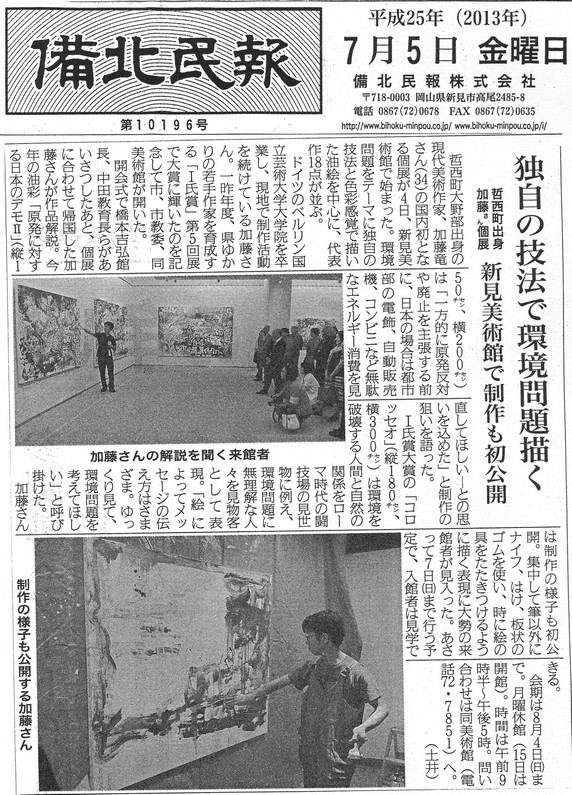

Newspaper article in the "Bihokuminpou" (Japan)
With an individual style, he paints about environmental problems. The solo exhibition of Ryo Kato from Tessei-Cho
The first exhibition in Japan of the contemporary artist, Ryo Kato (34) from Tessei-Cho Oonobe begins on the 4th July at the Niimi Museum. His 18 exhibited oil paintings focus on the environmental problems. These individual colourful paintings were painted in a special own technique.
He graduated as a masterclass studentat the Berlin University of the Arts and works and lives in Berlin.The Nimii Museum and the Municipal Commission are exhibiting his works to memory for the 5th "I-Shi" award, which Ryo Kato won. The "I-Shi" Prize was established for the distinction for young artists who are associated with Okayama.
After the museum owner, Yoshihiro Hashimoto and the school director, Nakata, greeted at the opening, Ryo Kato gave an introduction to his art. He said that the work "The Japanese Demonstration Against Nuclear Power Plants II" (150 x 200 cm) from this year contains the following ideas: "Before you bash one-sided NUCLEAR power plant and exact the ban on Nuclear power plants, as in the case of Japan, one should think about the waste of electricity by decorative lighting, vending machines and 24-hour Shop first."
In the picture "Colosseum" (180 x 300 cm) with which he won the "I-Shi" prize, the metaphor of the games in the Roman Colosseum is taken up and the struggle of mankind which destroys nature.Other people are depicted as mere spectators which are not interested in environmental problems.Ryo Kato says, "At every work I used a different method of mediating my message. I hope, that the visitors for my works take much time and think about environmental problems."
Ryo Kato showed for the first time in public how he paints.He paints not only with the paint-brush, but also with the painting knife, the spatula brush and the rubber spatula,sometimes he paints as if he belts the canvas. The spectators were impressed by his painting manner. He paints in the museum until July 7th. All visitors can watch there. (Doi)
04.07.2013
Social and environmental problems in the work of art
Newspaper article in the "Sanyoushinbun" (Japan)
The contemporary artist Kato from Niimi
His first inland solo exhibition in his home from today
The special exhibition of the contemporary artist Kato (34 years old, living in Berlin) from Niimi, who is exhibiting for the first time in Japan, begins on July 4, 2013 at the Niimi Museum.The painting "Colosseum", with which he won the first place in the 5th I-Shi Prize competition, and current works, a total of 18 works, will be exhibited until 4 August 2013.The artist was born in Niimi, graduated from Okayama Gakugeikan Gymnasium, emigrated afterwards to Europe and concluded study art at the Berlin University of the Arts as a master class student.At the time he exhibits his works, whose topic are environmental problems, primarily in Germany as a life / work centre in the field of contemporary art.In the painting "Colosseum", he depicted the people who viewed the clash between mankind and nature with disinterest as visitors of a coliseum in Roman antiquity.For the first time, he publishes his works in Japan that sharply criticize social problems such as demonstrations against nuclear power plants in Japan, air pollution and others.The museum's curator Shigeki Fujii says that the very new expression of his works, that criticize social problems, makes a strong impression. In some works one can sense that the artist thinks of Japan, although he lives in Berlin. “I would like that the visitors take a lot of time with looking.”
At 9:30 the opening ceremony begins. From 10:00 am, Kato comments on his works and invites to the daily Malperformance in the museum until 7 April.
09.02.2013
Newspaper article in the "Iserlohner Kreisanzeiger"
Jutta Bengelsträter presents the Japanese artist Ryo Kato and 30 of his large-format paintings in the gallery of the Parktheater. The Berlin-based painter comes to the exhibition opening on Sunday.
From Cornellia Merkel
Iserlohn. "Ryo Kato is the first Japanese artist to have received one of the country's biggest art awards and this year he is the first museum exhibition in his homeland", Jutta Bengelsträter is pleased that she already shows the Berlin-based artist for several years in her gallery program.
On Sunday, February 10th, at 11 o'clock, the artist comes to the opening of his exhibition in the Iselohner Park theater which shows his 30 large-format paintings in cooperation with the Gallery Bengelsträter.
„Ryo Kato apply himself to a painting whose style his teacher Daniel Richter has moulded“, explains his gallery owner Jutta Bengelsträter. The relationship between man and nature, the threat outgoing from humans is ubiquitous in his work. On the way to comprehend his paintings, the way we find exactly realistically painted scenes. Through the confused image compositions Kato inspired to discover and achieved not only increased attention for his art, but at the same time stimulates thinking about a more responsible society."
The artist born in 1978 in Niimi who lives since his art study in Berlin and works is an extremely political artist as already his crass painting titles make clear. In violent and wild picture worlds like „The big food“, „scandals in the sea“, „hunter and consumer“ and „fight without winners“ he pillories environmental pollutions, war, consumption mania, hunger in the world and cruelty to animals in the countries of this earth in. Ryo Kato combines expressive motifs and symbols in his multi-facetted apocalyptic image cosms with an unusual entwined ornamentation and proliferating diversity of form. "The Last Supper" is a famous motif in art, not only because Leonardo da Vinchi immortalized Jesus and his disciples. Ryo Kato's "Last Supper of the Present" fabricates references to the G-9 World economy Summit meeting and shows environmental pollution and hunger around the globe. He connects untouched landscapes and destroyed living spaces of person and animal also in his paintings, "Oil Sanding Industry in Canada" and "Struggle for survival in the Rainforest". "Fur queen vs. poacher king "and" Hippos do not like a fight ".
The exhibition is open until April 28th at all shows - one hour before the beginning - as well as upon consultation with the cultural office. In addition also a catalog is available, which introduces into the confusing and confused painting worlds of the artist. The entrance is free. The vernissage will be inspired musical by the saxophonist Charly Janke.
23.03.2012
Newspaper article in the "Bihokuminpou" (Japan)
"I am glad that my efforts have been worthwhile."
Ryo Kato (from Tessei-chou, Oonobe) won the first prize.
The fifth presentation of the I-Shi Prize of the furtherances of Okayama Prefecture for Creative Artists took place in a hotel in Okayama City on 22 March. Ryo Kato, who won the first prize, came to the presentation of award from Germany to receive the certificate and prize money from Governor Ishii. Kato will stay in his homeland until tomorrow, March 24th.
The I-Shi prize is only concerning artists, to find their roots in the Okayama Prefecture are awarded and opened the laureates in addition exhibition possibilities. Promoting next-generation artists is the declared goal of this award. The award was made by the donation by Kensuke Itou (adviser of Kyosera), the selection procedure is escorted by the management committee of the prefecture Okayama and the curators of the urban museum.
This year, 39 artists were proposed by the committee members, of whom 10 candidates were preferred after the first selection stage (the documentary check). Between January 24 and February 5, 2012, the works of these candidates were to be seen on the selection exhibition at the Tenjinyama Cultural Plaza in Okayama City.
Ryo Kato, whose theme is the environmental problem, exhibited his work "Colosseo" (180x300cm), in which nature and people fight against each other and in addition, uninterested people for environmental problems are seen as spectators of this struggle. His work was highly valued by the jury: his painting possesses overwhelming energy, a beautiful picturesque color and expressive motifs. In addition, it was notably emphasized that his work expresses a clear social problem awareness and an appealingly implemented opinion.
At the presentation of award also two further winners, the committee members, altogether about 50 art parties concerned from the prefecture were except Ryo Kato present. Governor Ishii presented Ryo Kato the certificate and the prize money, which is endowed with 3 million yen (about 25,000 €), and commented: "his work shows socio-political awareness of the problem and impressive colored and sense maturity. I hope for his future success. Also I am pleased that an artist from Okayama is active in the world." In the speech of Ryo Kato, he emphasized that he was pleased that his efforts to make people aware of the environmental problem with his art have paid off. "With this opportunity of the prize profit I would like to try to exhibit my paintings also in Japan." Ryo Kato brought his daughter to Japan (19 months old). Today 23 March and tomorrow he spends the in his home; on 28 March, he returns again to Germany.
28.09.2011
Newspaper article in the "Iserlohner Kreisanzeiger"
Exhibition at Bengelsträter: "A blind samurai goes through the world"
"A blind samurai goes through the world".
Zeitungsartikel im "Iserlohner Kreisanzeiger" Under this title is the exhibition of the artist Ryo Kato from Berlin, which was opened at the weekend in the gallery Bengelsträter. The artist himself was present at the vernissage on Sunday after he already had been visited by a filmteam from Berlin in the gallery during the "Preview" and had been asked about his paintings. He reported, among other things, the emotional ties that he built up to his creations, and that each one is very important to him. Also some visitors could already have a first look at his art on this day and at the same time get a static role in the shooting. The colorful and impressive works of the young artist are now hanging out in the gallery until the 28th of November.
Photo: Tim Haacke
Ausstellung bei Bengelsträter: „Ein blinder Samurai geht durch die Welt“
„Ein blinder Samurai geht durch die Welt“. Unter diesem Titel steht die Ausstellung des Berliner Künstler Ryo Kato, die am Wochenende in der Galerie Bengelsträter eröffnet wurde. Der Künstler selbst war zur Vernissage am Sonntag anwesend, nachdem er bereits am Samstag von einem Filmteam aus Berlin in der Galerie bei der „Preview“ besucht und zu seinen Bildern befragt worden war. Er berichtete unter anderem von den emotionalen Bindungen, die er zu seinen Schöpfungen aufbaue und dass jede einzelne ihm sehr wichtig sei. Auch einige Besucher konnten an diesem Tag schon einen ersten blick auf seine Kunst werfen und gleichzeitig eine Statischen Rolle bei den Dreharbeiten ergattern. Die farbenfrohen und eindrucksvollen Werke des jungen Künstlers hängen nun bis zum 28. November in der Galerie aus.
Foto: Tim Haacke
04.08.2011
Newspaper article in the "Mainichishinbun" (Japan)
The oil paintings from Germany, which exit appeal to the exit of the nuclear power plant
Ryo Kato, the artist from Niimi, visited his home again after five years.
After the nuclear power plant accident in Fukushima, the originating from Niimi and Berlin-based artist, Ryo Kato (32), eagerly paints oil paintings that appeal to exit of the nuclear power plant. He visited his home after 5 years again and says: "I would like to convey my message about man and nature the world." After the big earthquake in the East of Japan, he has painted 10 oil paintings about this happening, a main painting is called "The blind Samurai goes through the world" (180x240cm).
In the center of the painting are the nuclear power plant accident and a Japanese, who looks like a Kabuki actor. The U.S. President, Obama, the Chinese President Jintao and Sarkozy, the President of France are portrayed on the edge of the painting. With it he wants to express, that this incomparable accident shocked worldwide. He had painted this work in 2-3 weeks. There are also works that have the following titles, "evil vs. good in the 21st century", "Acid rain", and "The tired USA". Ryo Kato developed his own style, which is a mixture of realism and fantasy. His art can be seen on his website: www.ryokato.de. Ryo Kato after graduating the Gakugeikan high school has moved to Paris, then emigrated to Berlin and lived there for 13 years. He gets international recognition.
22.06.2011
Newspaper article in the "Welt" (Germany)
Five artists the overseas boulevard
The guests celebrated art, talk and wine until midnight: as part of Art Week, Jenny Falckenberg and Annika Littmann of the Kunstagentur fl organized with Marlies Wrede a successful Art Night in and on the Überseeboulevard in the Hafencity. Five artists showed their new works in the still unplastered, future business rooms: ... Galerist Anne Moerchen, who for the second time exhibited the Japanese artist Ryo Kato, living in Berlin, was also brought to the boat. He completed the masterclass of Daniel Richter and discussed the exploitation of people and nature.
13.12.2010
Article in the magazine "Tango"
Japanese delicatessen
In Ryo Kato's painting worlds the chaos reacts. Forms and colors formal fall into each other. In driving color landscapes objects and abstract wrestle with each other. The cause of his artistic work is the relationship between humans and nature. Environmental catastrophes that spring over us and the destructive exploitation of the earth by humans are the main motif of the mostly large-format canvases. Until Jan. 22, the work of the Japanese artist can be seen at gallery Anne Moerchen.
19.11.2010
Newspaper article in the "Live" (Germany)
Paintings of the fight against catastrophe
The Daniel Richter student Ryo Kato is exhibiting at Anne Moerchen.
GALLERY ANNE MOERCHEN: "The art must always remind, drill, shake, arouse." Ryo Kato says and paints his paintings inspired from the fight against oil and other environmental disasters, the exploitation of nature by the people.
The style of his teacher Daniel Richter has strongly influenced the artist who was born in Japan in 1978 and has lived in Berlin for twelve years. In Katos, for example, works that bear titles such as "atomic lie" or "sandstorm in China", forms and colors collide, objects and abstracts wrestle with each other in sometimes exuberant color landscapes.
It can be seen until 22 January in the gallery Anne Moerchen (Jöm)
Without title, but overwhelming intensity. This painting Ryo Kato painted this year in oil on canvas; In the original it is 160x120cm large.
March 2010
Newspaper article in the "Odenwaldkreis" (Germany)
If Japan is too small
Artist-feeling - Ryo Kato exhibits in Michelstadt and raves about Berlin, where his mastership attains and now takes effact.
Michelstadt. Niimi, Paris, Berlin, Michelstadt: Ryo Kato's Japanese home with two metropolises Michelstadt treads in a row, after now also the gallery Kautsch at the Mauerstraße 9-11 gave the young Asian artist a exhibition. Born in Southwest Japan in 1978, the creative artist graduated a training in drawing and Painting at the high school and private schools in Okayama between 1995 and 1998.
Already during the study came to recognition and distinguished among other things with an international art and culture award, Kato changed 1998 to Paris. The works Monets had fascinated him. But not the French capital should be the European home of the Japanese, but Berlin. He went there in 2001 to complete a study at the university of the arts till 2005. Under Professor Wolfgang Petrick and later as a master class student under Professor Daniel Richter, Kato reached artistic maturity.
Kato said Japan had become too small to him, on Saturday in Michelstadt compared to the ECHO.
He felt the desire for other continents and the desire to get to know foreign cultures. He felt Berlin in comparison of the cities as the loosest. There you can enjoy freedoms. "Berlin attracts artists, many galleries settle down," said Ryo Kato.
The large-format paintings which are to be seen in Michelstadt bear names such as "gorillas for gourmets", "hopeless struggle" or "man and nature".
You must make as a viewer in search of, and in the paings, gallery owner Veronika Kautsch said in her greetings. At the paintings, above all positive aura attracts attention. Every interested party may be in Michelstadt his own picture of the effect of creativity of Kato until April 10. At the same time, the Japanese is represented in the "Art Karlsruhe" during these days. It lasts from 4 to 7 March.
Impressive paintings fill at the moment the gallery Kautsch in Michelstadt; the owner Veronica Kautsch wangles the Odenwald culture that with it that She won the Berlin-based Japanese Ryo Kato (right) for an exhibition.
22.06.2009
Newspaper article in the "Westdeutsche Zeitung" (Germany)
Summer freshness in galleries
By Helga Meister
Art knows no holiday. These shows the tour also through the new access.
The moving of new galleries stops. Economic downturn or holiday atmosphere, there is nothing to feel. Here are a few recommendations:
Ryo Kato is masteclass student of the cult artist Daniel Richter, and at first sight one sees commonalities: Teachers like former students practice criticism of the world, but Kato loves exuberant motifs. There the cat pukes, the leopard is only a fur cover, the monkey sits on a powder barell or runs by an oddment of forest. Devils, masks and ghosts and a horse without apocalyptic riders push themselves through the scenes. A bloody book, a hamburger with a dagger, steamy industrial chimneys and stranded birds can be found on the explosion paintings.

